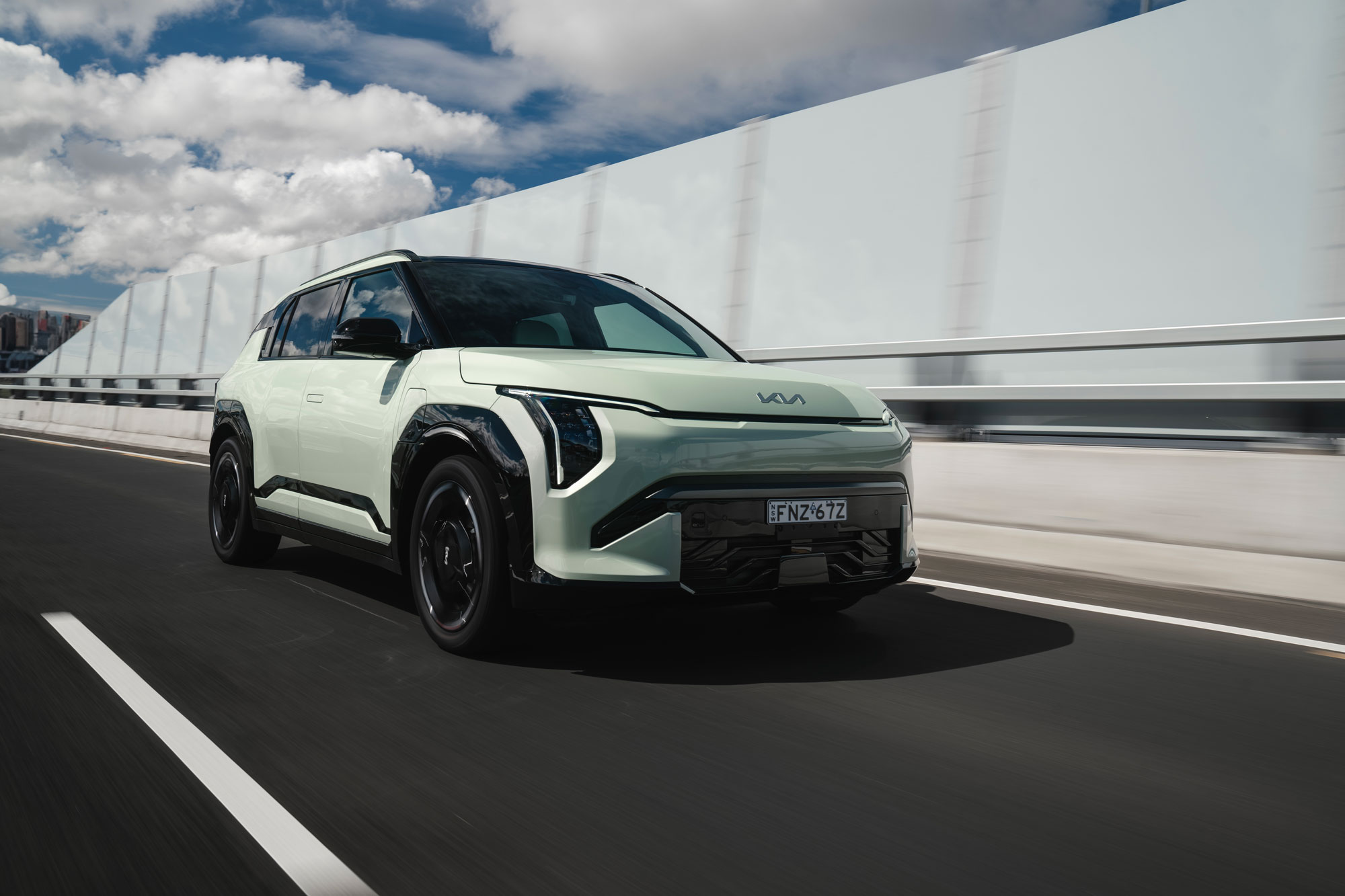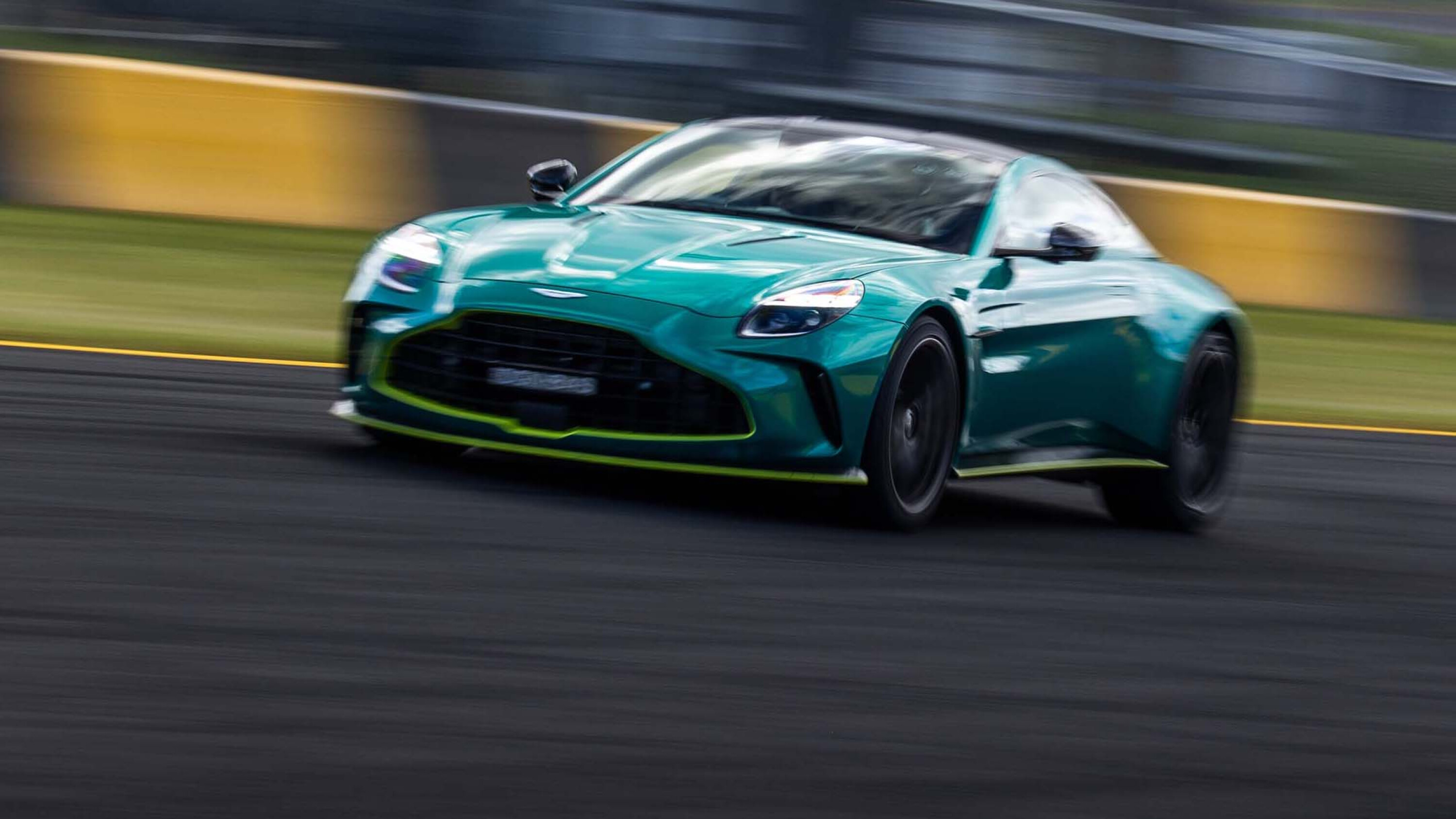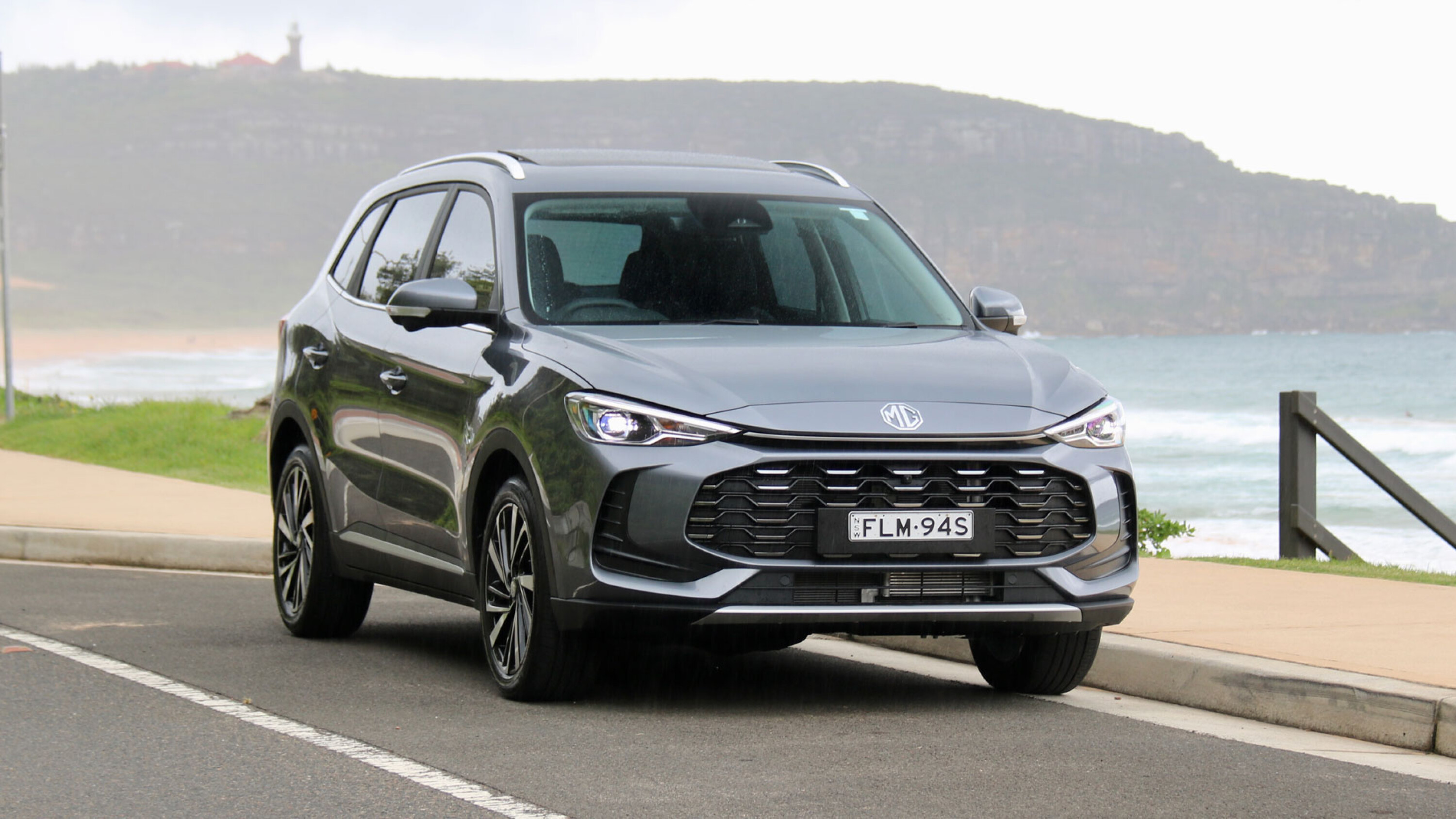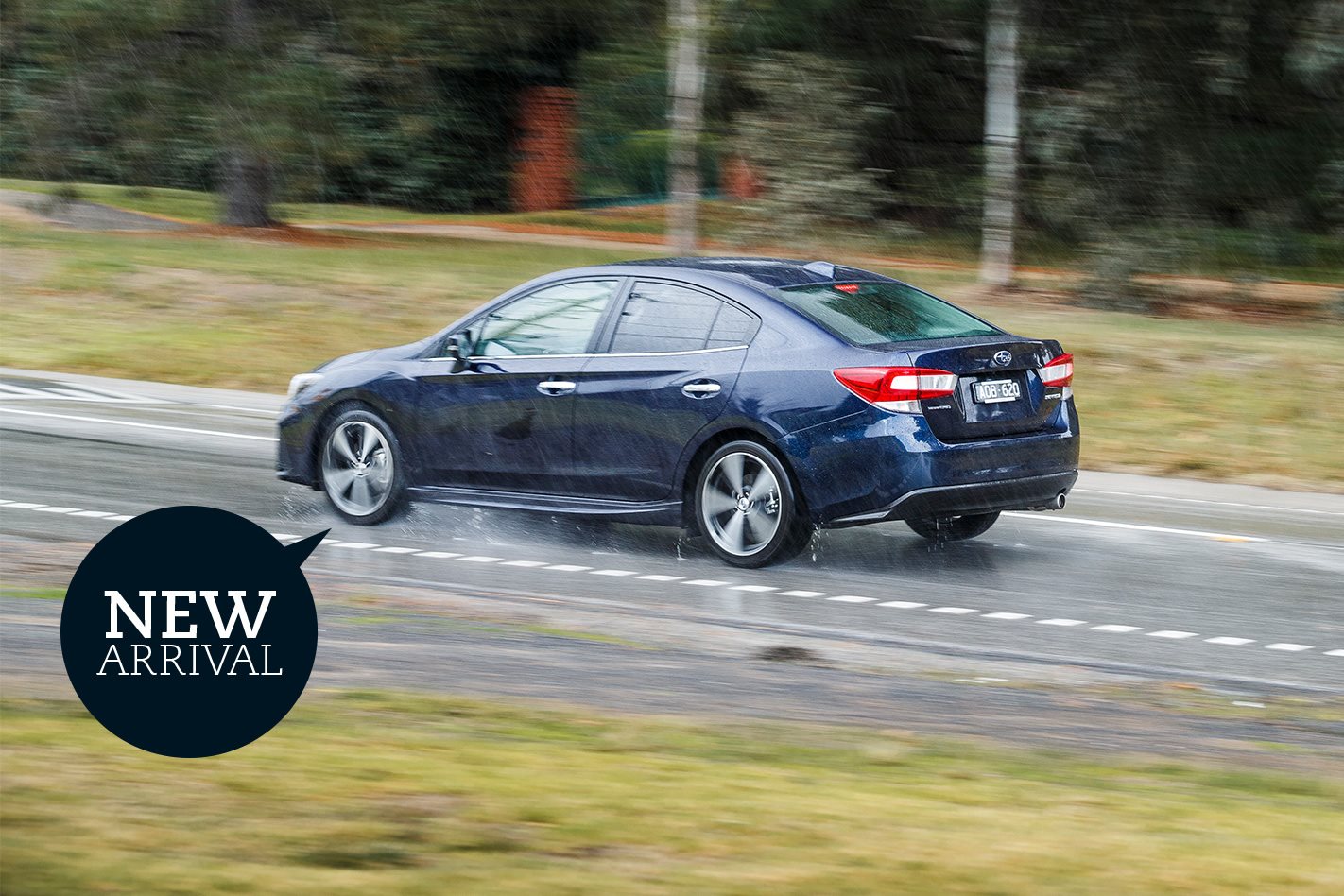
- Part Two: Subaru’s EyeSight proves itself in the real world
- Part Three: Baz finds cornering the Impreza is a game of two halves
- Part Four: How well does Subaru’s off-road heritage translate to the new Impreza?
- Part Five: Winter sports are enough to test anyone’s mettle
- Part Six: Glancing low blow sidelines Bazza’s Impreza
- Part Seven: Booted Impreza gets filled to the gills
- Part Eight: Subaru calls time on Barry’s extended Impreza tenure
Down Under is now a marketplace where small cars, such as Subaru’s Impreza, need to make a big noise to stand out.
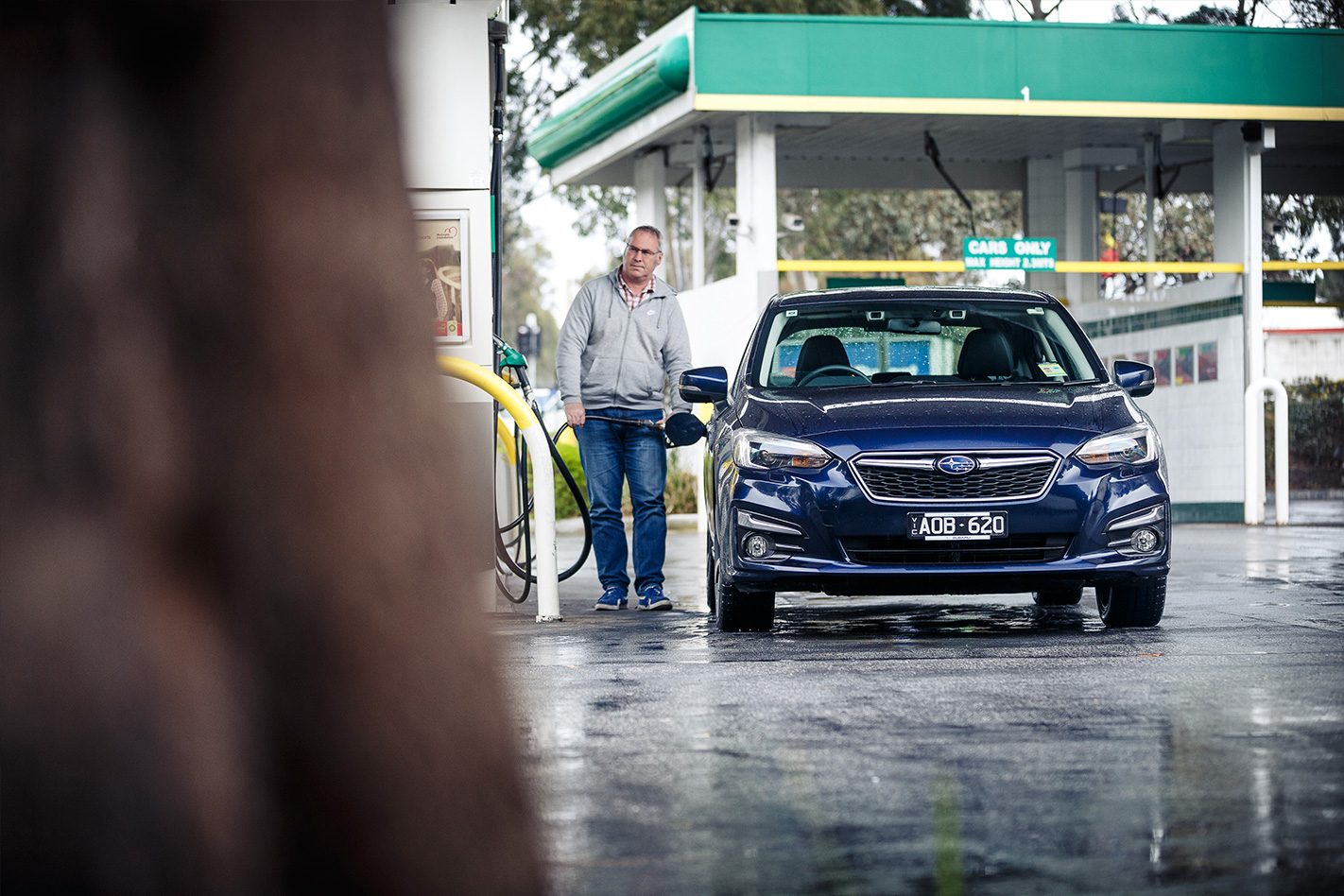
Generation G5 of the Impreza, a 2017 Wheels Car of the Year finalist, has introduced the world to the Subaru Global Platform (SGP): a lighter, stiffer all-new modular chassis that will underpin future models, including plug-in hybrids.
COTY testing clearly showed that the SGP is able to reacquaint the driver with something long absent from Subaru’s DNA; a level of dynamic prowess for which the Japanese carmaker was once renowned.
A booted version of the Impreza now joins the Wheels garage as a long-termer. Just like the five-door, the G5 sedan introduces a better-looking design featuring much sharper looks than the dowdy cardigan the previous generation wore. It’s something that will help it stand out in what remains a cut-throat segment in Australia, and one where the Subaru-badged contender snares only one in every 20 sales.
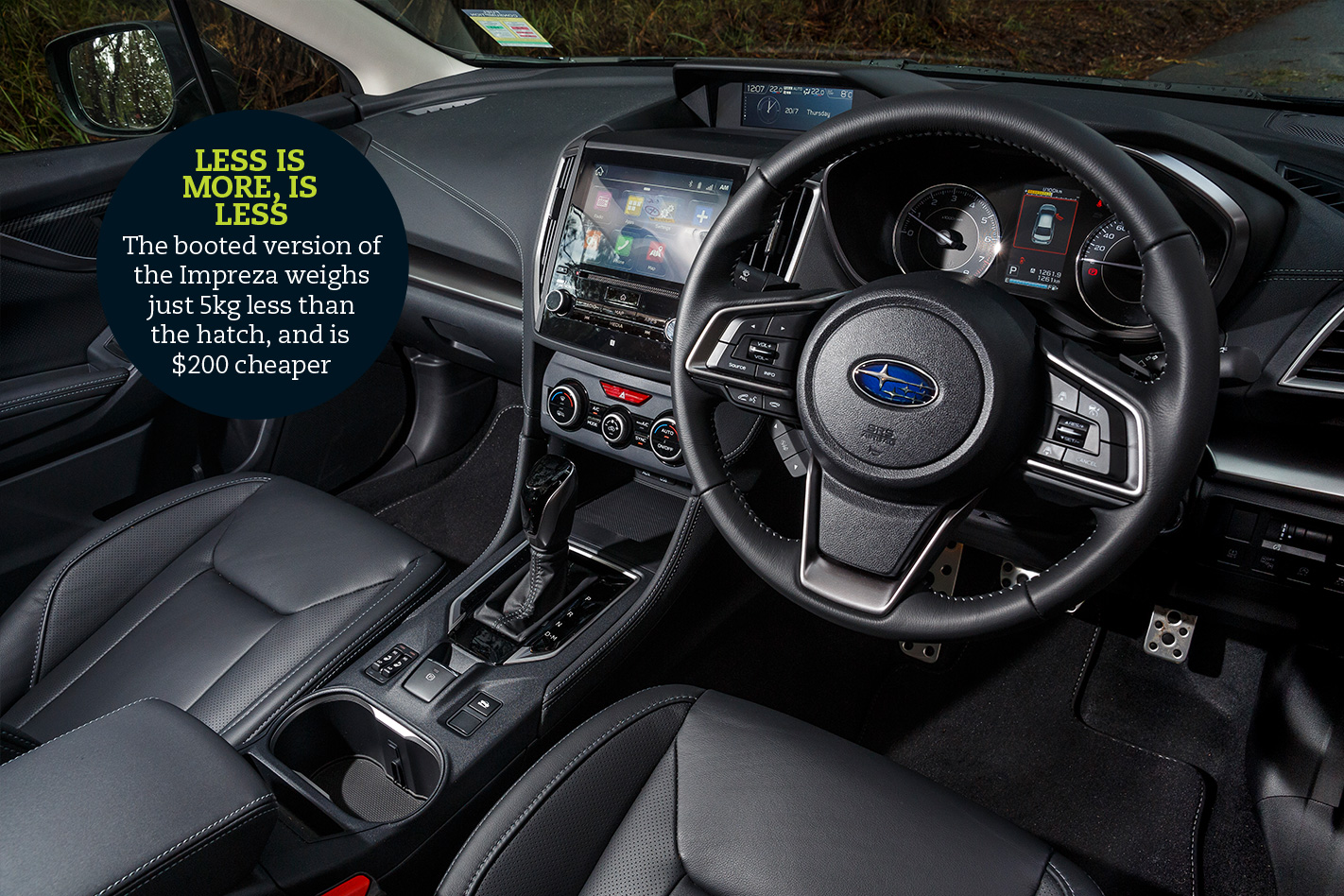
The SGP’s improvements extend to the inside as well, where Holden Commodore-rivalling interior space and comfort mark the Impreza as a genuine cross-shopping alternative to the doomed large sedan.
We’ve already pegged the fitout of our long-termer, the richly equipped 2.0i-S, as the pick of the Impreza litter. This is largely down to the generous equipment list, which includes heated leather seats, LED headlights, a torque-vectoring diff, and stickier 18-inch Yokohama Advan Sport rubber.
It will have a big burden to carry: there’s been a hole in my driveway for a number of years, a space set aside for the 1990s-era bug-eyed Impreza Sportback my wife has always dreamed of, but never owned.
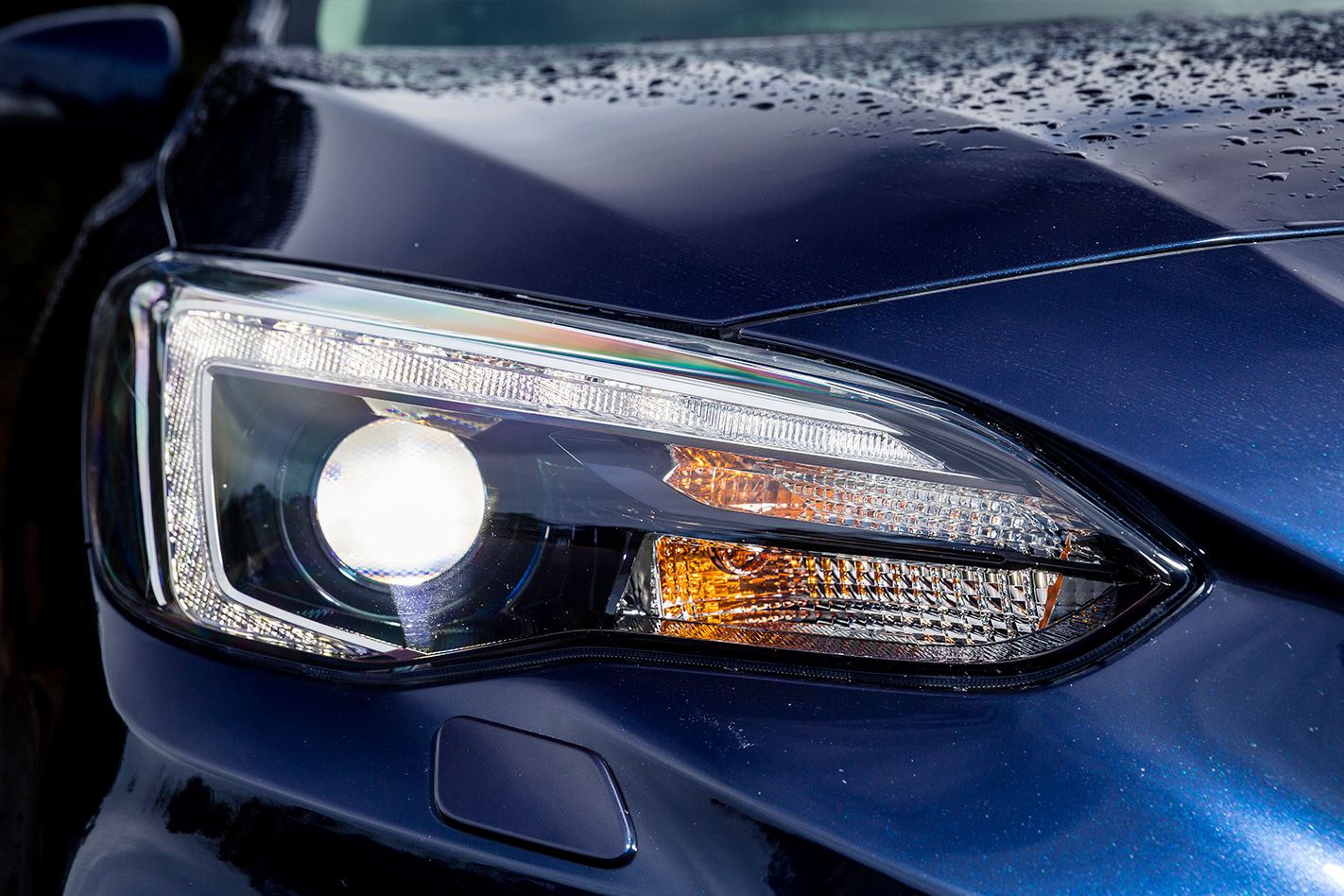
That driver’s DNA is something I’m keen to explore over the coming months, and given Subaru’s renewed interest in rallying in Australia, I’m also keen to extend at least a small part of that testing to gravel surfaces.
What’s welcome most of all, though, is that generous-sized boot. At 460 litres, the sedan’s 115L advantage in luggage capacity over the hatch is bound to come in handy with four children in the brood.
Troubled outlook?
One of the technologies we will be keen to test in our new long-termer is EyeSight, Subaru’s dual-camera system that scans the road ahead and jumps in to slam on the brakes when it thinks the Impreza is about to crash.
We’re not off to a good start, though, with heavy fog blinding EyeSight and forcing a warning on the dash that the system was unavailable.
We would, however, buy shares in Subaru’s windscreen wiper supplier; the wipers work hard to keep the EyeSight cameras clear of any condensation or raindrops.
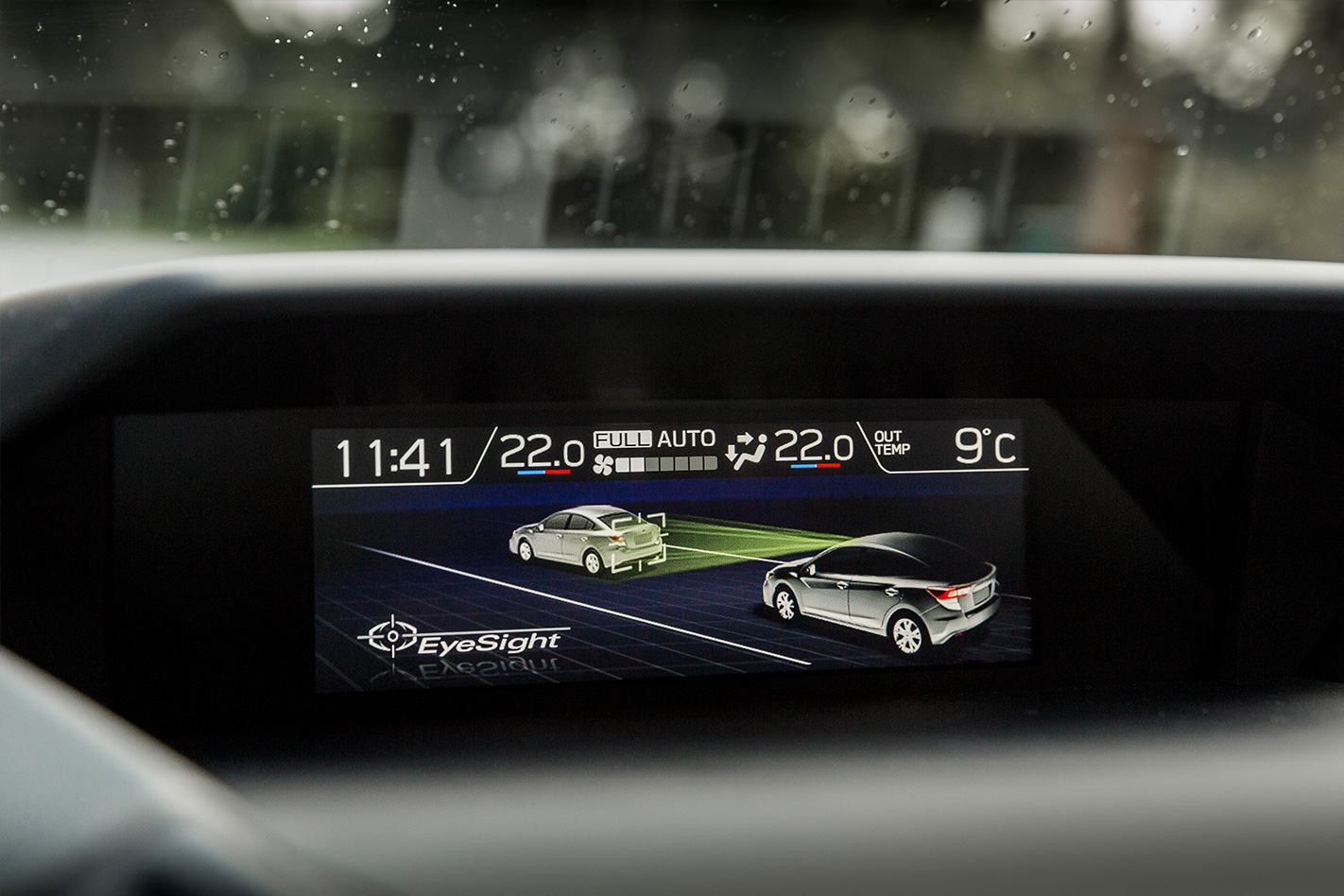
Part Two: Subaru’s EyeSight proves itself in the real world
THE stench of burning rubber is unmistakable. Acrid and sulphurous, and filling the Subaru Impreza’s cabin, pulled in by the air conditioning system.
Moments before, I’m travelling along the freeway at 80km/h. Traffic is heavy but moving well as everyone tries to get home at the end of another busy week.
Suddenly, without warning, the dash lights up red and the car beeps urgently as it automatically jumps on the brakes, quickly bleeding speed as the car in front slows hard. The brake pedal, when my foot reaches it but a heartbeat later, feels wooden under my foot, but still the Subaru keeps pulling up, coming to a complete stop with a good half a car’s length of extra stopping room remaining.
Welcome to my first-ever real-world demonstration of Subaru’s EyeSight.
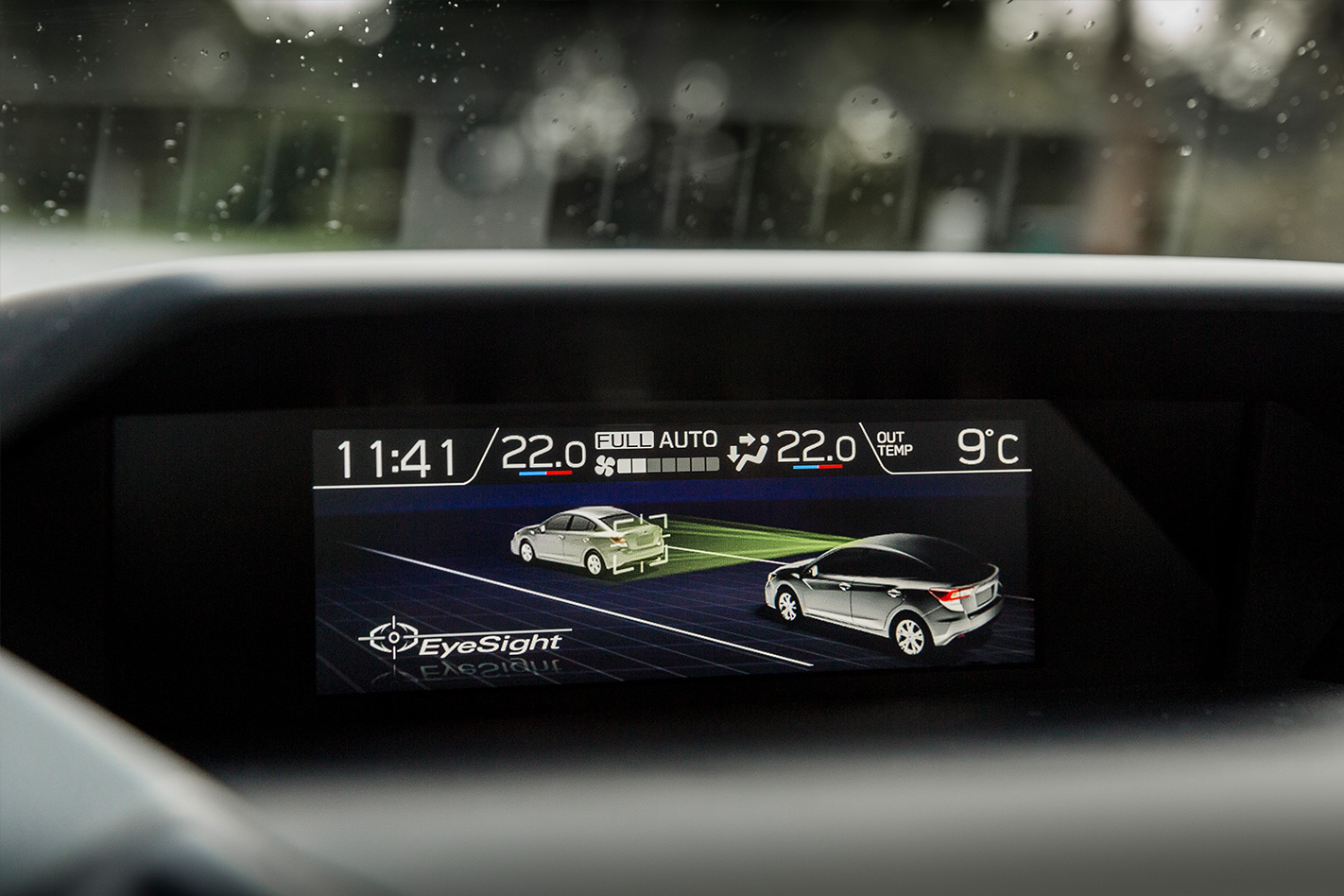
It’s the Japanese car maker’s autonomous emergency braking system and has just done for me exactly what it’s designed to do. The reason the Impreza reacted soon becomes clear; four damaged vehicles are stalled in the fast lane, the drivers out and exchanging details as they survey the aftermath of the peak-hour nose-to-tail conga line.
The Impreza was able to register the flash of brake lights in front of me and grab the brakes more quickly than I could. But what I liked about the autonomous braking was that it pulled up smoothly, the Impreza bleeding off speed calmly and giving the car behind enough time to do the same. I don’t know if I could have done it with the same calmness and control as the EyeSight system.
It’s an electronic safety net I really appreciate. To set the cruise control and let the Impreza handle the tension of keeping a safe distance to the car in front makes a big difference to my long daily commute.
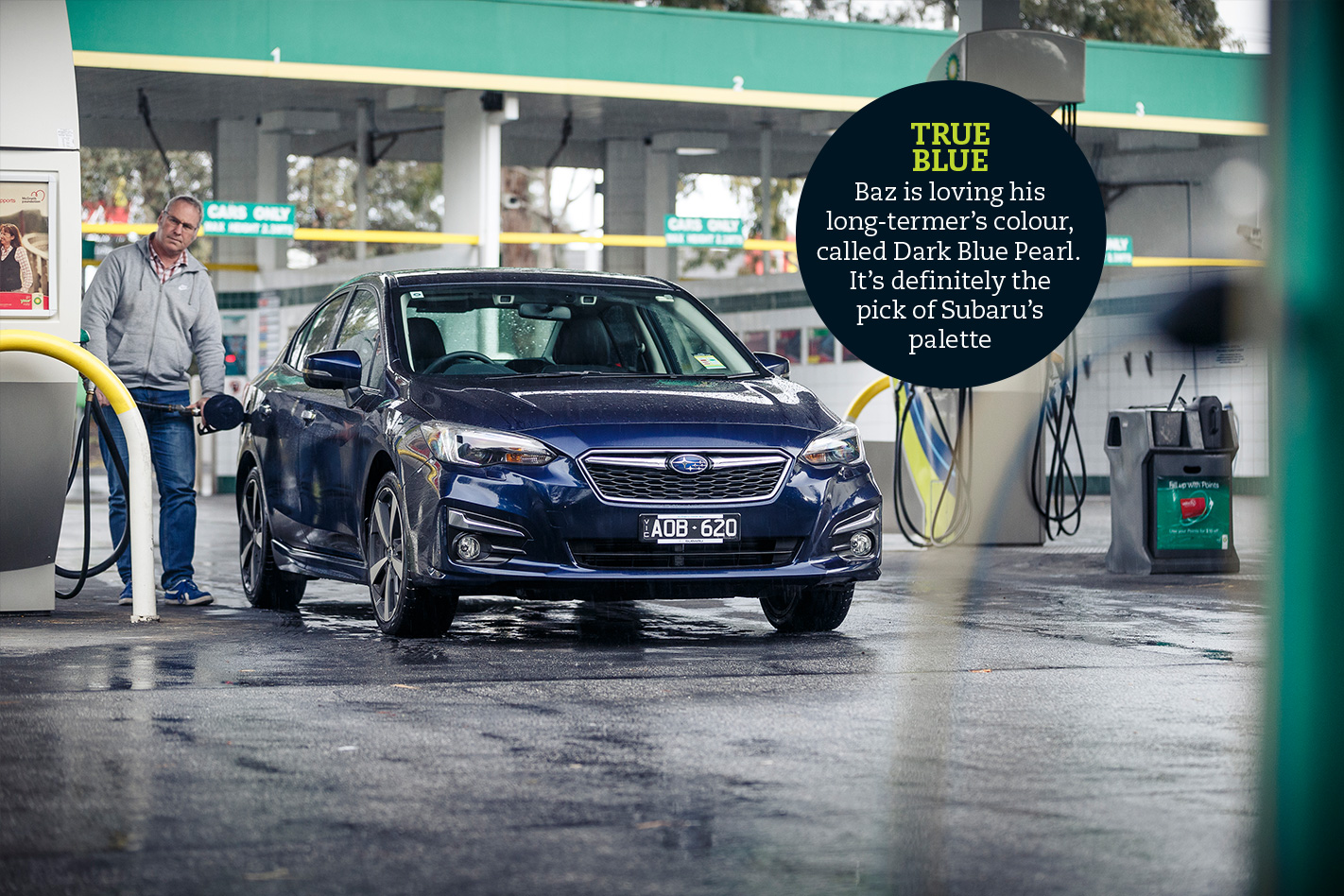
In contrast, though, I’ve kept the lane-keep assistance system off. I find it way too sensitive, beeping even if I stray slightly off centre. Combine it with the beep from the cruise control every time a car jumps in or out of its range, and it can become irritating.
More helpful, though, is the system that watches out for passing traffic as you reverse out of a parking space. A trip to Bunnings, where there’s a sea of SUVs and trade utes, highlighted this.
But why is it a feature only on the most expensive Impreza?
Five into four won’t go
The top-spec Impreza sedan comes with four USB ports as standard; two located awkwardly deep in the centre console and another pair in the storage space under the front seat armrest.
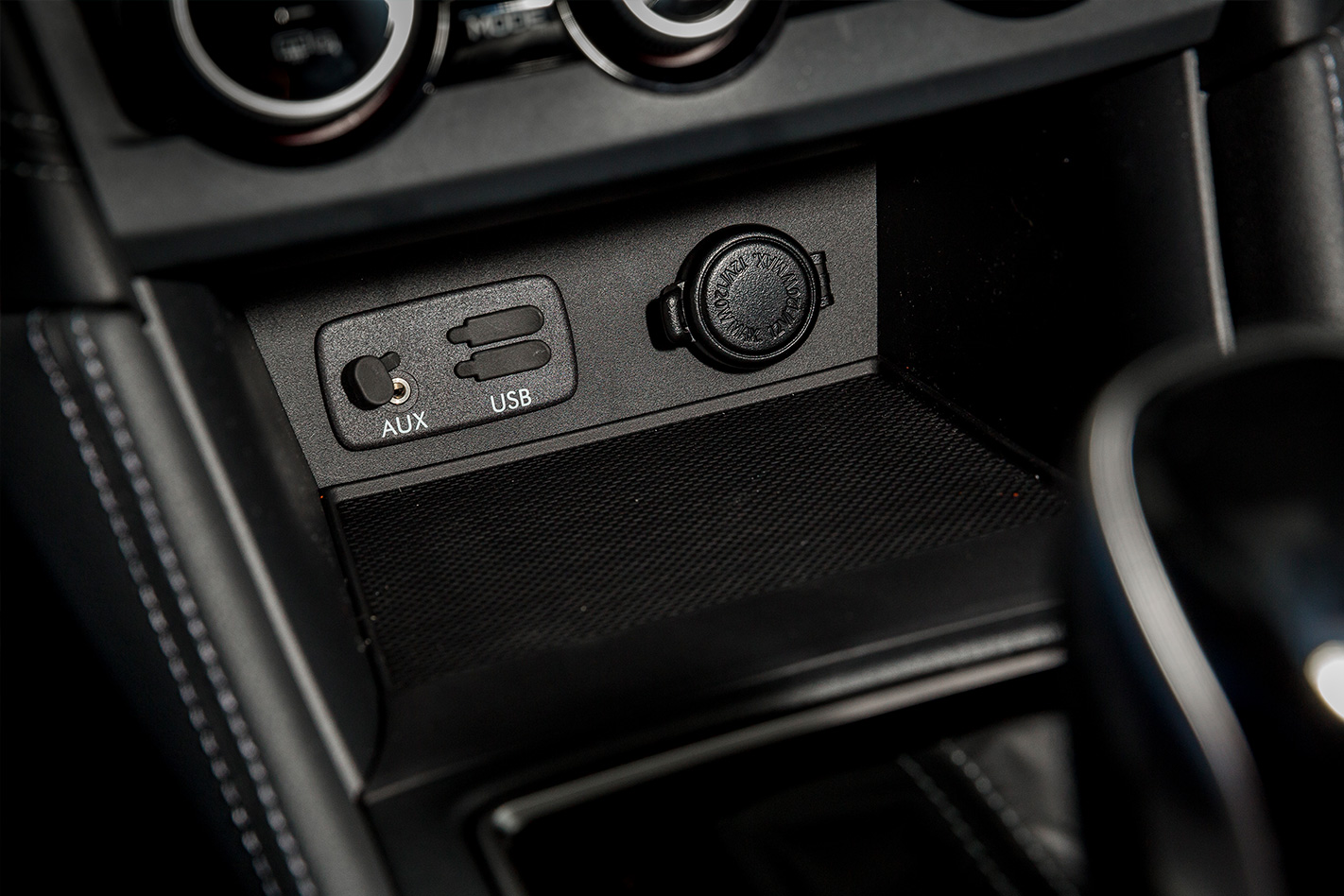
The front two link up to the multimedia head unit, while the rear ones just provide juice for hungry electronic devices. So what do you do when there are only two charging points and three kids in the rear quarters?
It’s somewhat traditional that the youngest, sitting in the worst seat in the house – the middle – misses out.
Part Three: Baz finds cornering the Impreza is a game of two halves
I’VE discovered a new game in the Subaru Impreza: if I’m driving a twisty section of road, I left-foot trail-brake deep into a corner.
This loads up the Impreza’s front end on corner entry, with weight shifting forward to lean on the outside 18-inch Yokohama. The squat centre of gravity – the low-mounted boxer engine endows the Impreza with a surprising ground-hugging ability – shifts subtly, endowing the front end with imperious grip.
Applying the throttle at this point, even before you reach the apex, helps to offset the dull-witted CVT transmission, as the clever electronic front diff kicks in to stop the inside front wheel from spinning. The Impreza then launches itself out of the corner as though it’s being pulled by an invisible elastic band.
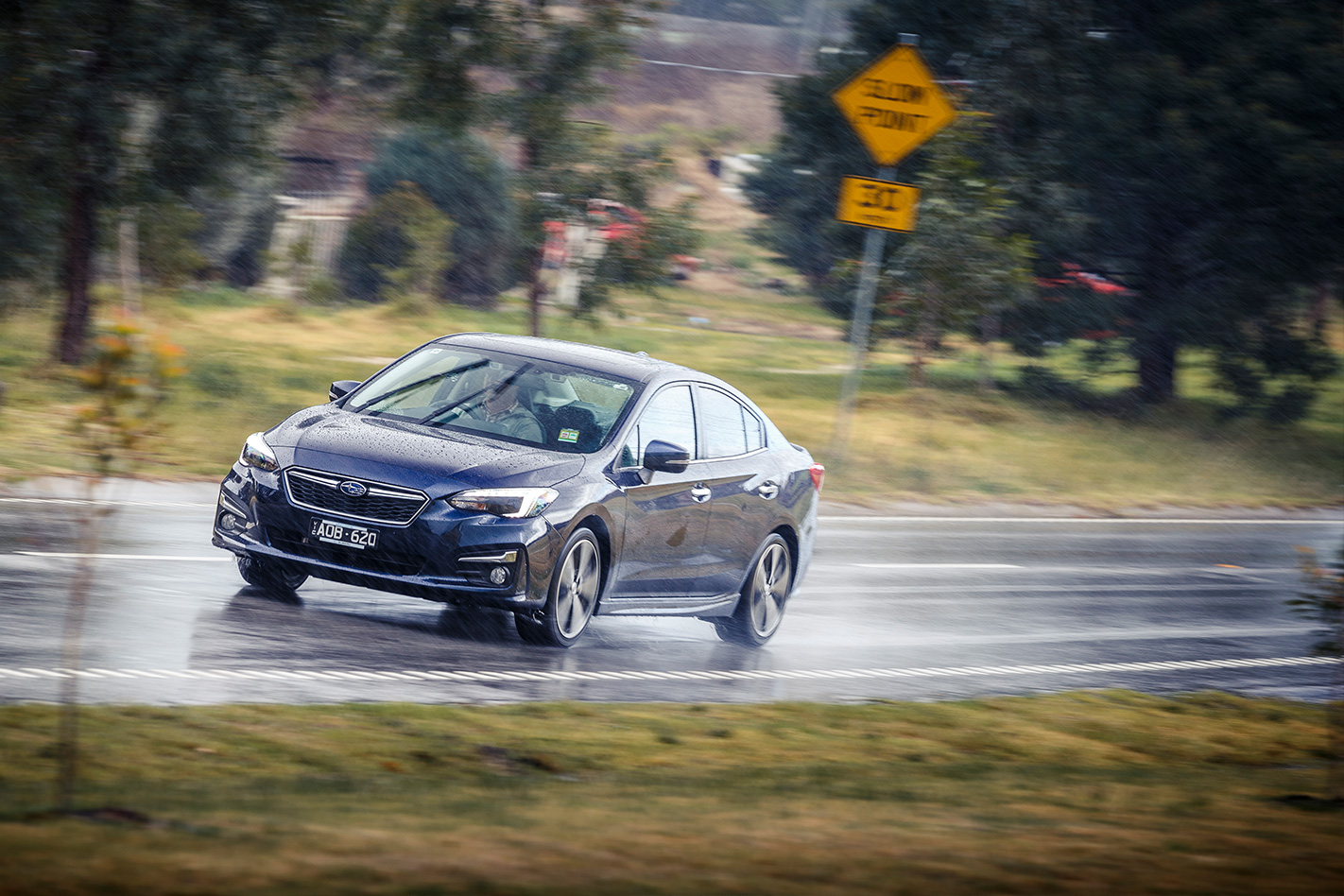
I’m not sure that this is the fastest way to get the Impreza 2.0i-S through a corner, but it sure is the most enjoyable.
Where I live backs onto what must surely rank among Victoria’s best sections of road, and regular trips to far-flung soccer fields and waterways provide the perfect opportunity to turn off the main roads and take the more interesting route home.
However, using these backroads means I’ve also found the Impreza’s limits, and it’s not the grip of those Yokohamas, which have been impressive in both wet and dry conditions.
Nope. It’s that bloody CVT.

Here’s something akin to one of the best-handling small sedans on the market. But tap into the Impreza’s deep well of dynamic ability and the snoozy auto takes forever to recover from a hard braking manoeuvre, dithering for what seems like a lifetime if you’re just jumping straight off the brake pedal and onto the accelerator.
The steering wheel-mounted paddle shifters, meanwhile, take what seems like an eternity to flag their intentions to the transmission, despite my spicy vocal encouragement. And seven artificial steps? Five would do nicely, thanks. Also, drive too enthusiastically while stringing close corners together and the brake pedal starts to get a bit long. Buttoning off a bit brings it back.
But I’m looking beyond these flaws at Subaru’s whole package. The Impreza is still a deeply engaging thing to punt along – more often than not I still find I’m avoiding the major byways and taking the significantly less-straight way home.
Heinous envy
I’m starting to have doubts that the sedan is the best-looking version of the Impreza. Yes, it’s impressively proportioned, particularly alongside rivals such as the Chevrolet Cruze-based Holden Astra sedan, but every time the rear end of a hatchback Impreza hoves into view, the thought arises that it, and not the booted version, is the more attractive design.
And after several trips to Bunnings I’ve found myself in situations where a more versatile hatch bodystyle would be welcome to stow bulkier purchases.
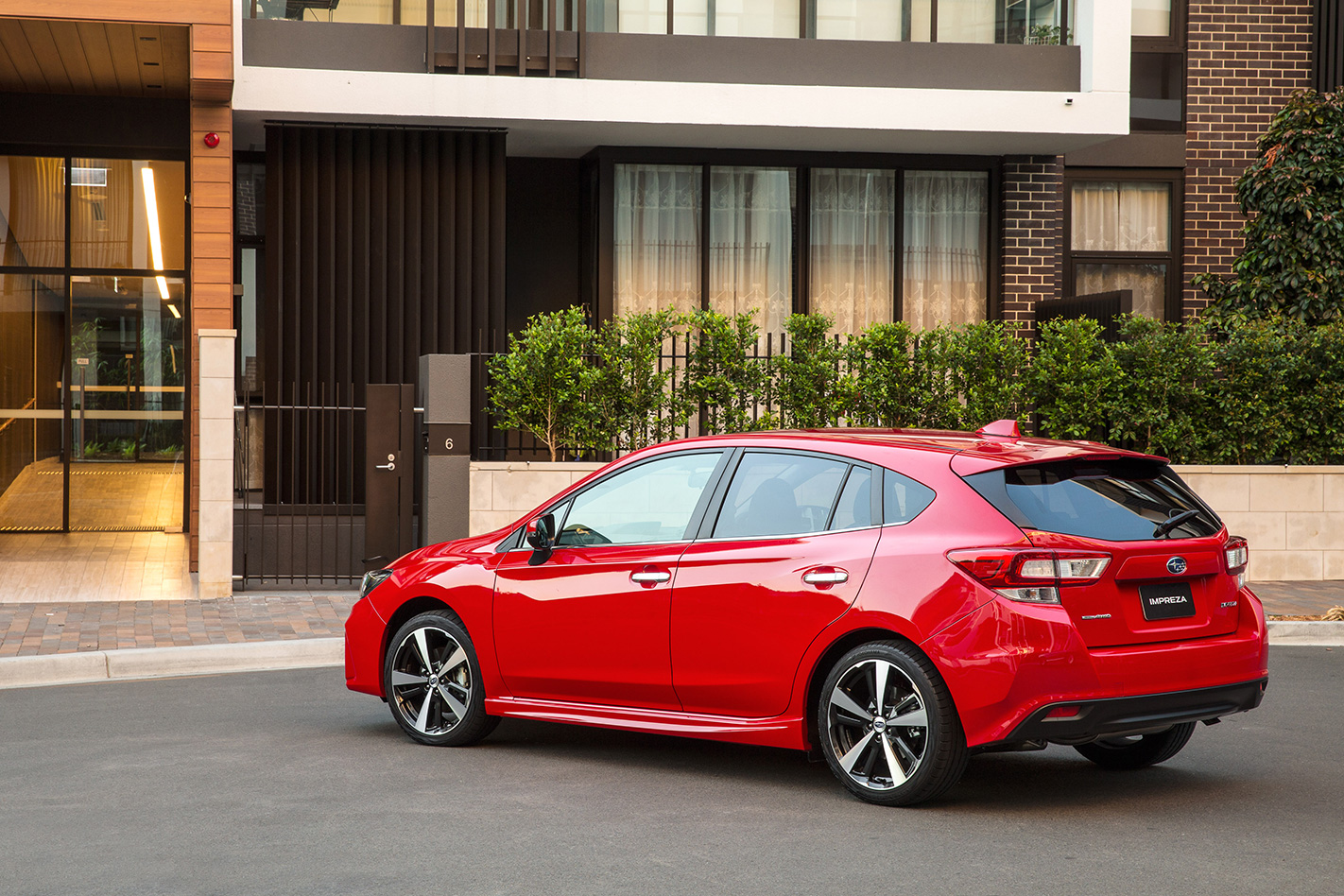
Part Four: How well does Subaru’s off-road heritage translate to the new Impreza?
CLUMPS of snow are scattered alongside the road, contrasting the yellow clay and grey dirt it is carved from. It’s a clear sign that we’re 1400m above sea level on the fringe of the Australian Alps; turn left, and we head up the short, steep and twisty climb to the Mt Baw Baw village, go straight ahead and we’re on the South Face Road.
The 30-kilometre-long South Face Road is the whole reason we’ve made the climb this high. The road is relatively new, only about a decade old. It skirts the southern edge of the Baw Baw National Park, running from the village turn-off to the thin ribbon of bitumen that links Moe with the Thomson Reservoir.
Wide and sweeping, its vista of rugged timber and fern forest is scarred only by the occasional logging coup it was put in to support. It’s also one of the best stretches of gravel you’ll find, and perfect for testing Subaru’s rally-bred heritage.
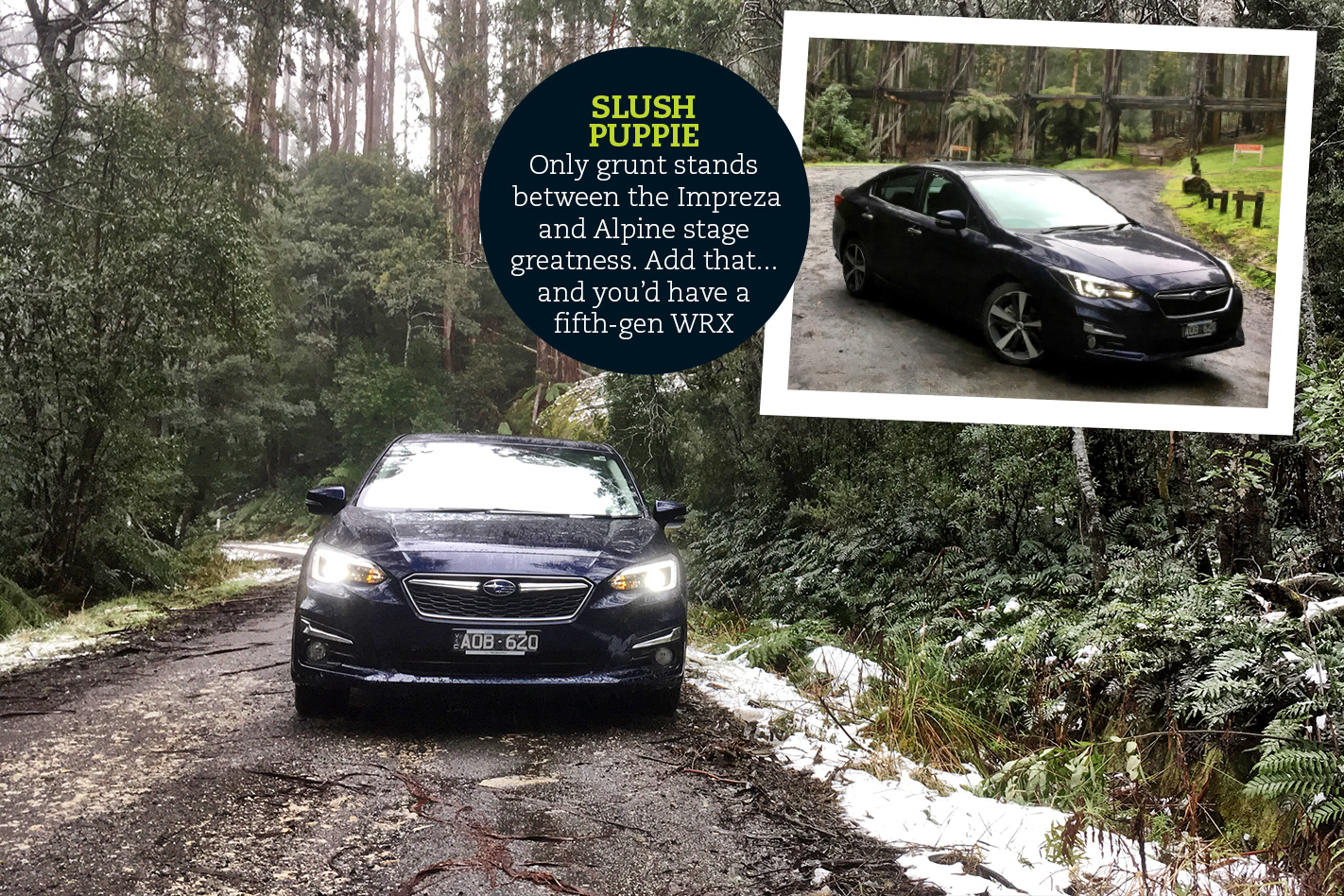
The road drops beyond the village turn-off. The loose gravel surface is in decent shape despite a solid week of rain that’s turned the ground beside it into a sponge. Pushing along, the Impreza feels nicely planted, soaking up the rough undulations and the corrugations formed in braking zones with surprising finesse.
There are some very wet patches, the road surface becoming soft and noticeably sapping forward momentum. The Subaru Impreza tries to yaw as one set of wheels tracks on relatively stable gravel while the other set drags through a patch of slippery mud. You can clearly feel the car’s electronic guardian step in to gently pull the Impreza back into line.
The road dips and weaves as it descends through dappled sunlight, startled currawongs dipping and wheeling from the trees above, while in front the occasional lyrebird bursts from the low vegetation on the roadside like the coyote’s roadrunner. Massive concrete viaducts cross the sharper, steeper gullies, rivulets of snowmelt cascading down them to the valley below. There is a surprising number of cars using the road, and equally surprising is that few of them are four-wheel drives.
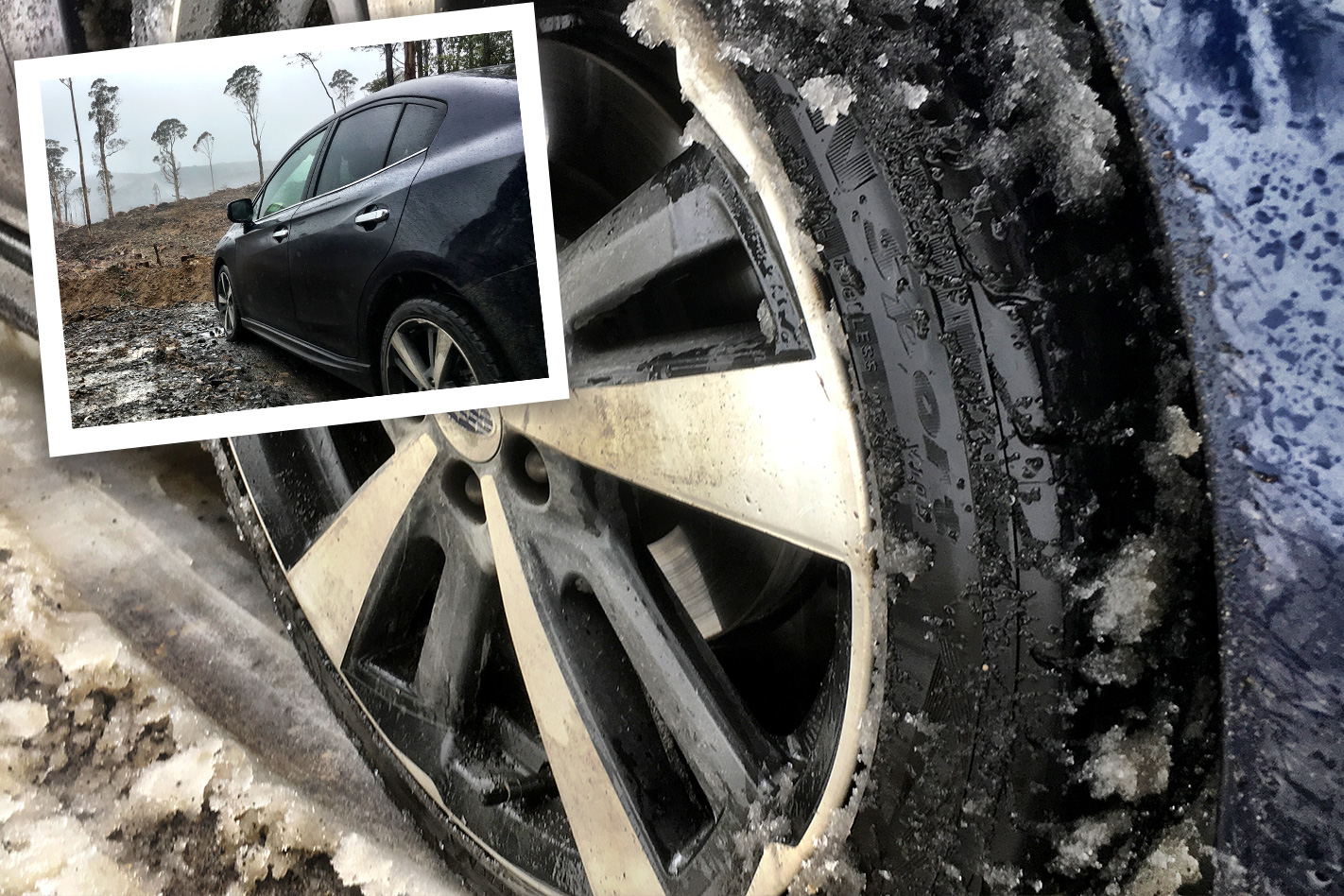
The 30 kays pass very quickly when you’re fully engaged with the drive. Parked up on a clearing that marks the end of our journey, the Impreza now looks like a proper rally car, its sides smeared with remnants of the road surface it had just confidently clung to.
Colin McRae would be proud.
Snow trouble
This month’s trip gave us the opportunity to hit the snow, taking the road up to the summit of Mount Erica car park a few kays north of where the South Face Road rejoins the bitumen. Here, the Impreza’s all-wheel-drive system shone; despite a 10cm cover, the Subaru ploughed up to the lower car park with ease (the closely related XV SUV with its more generous 220mm ground clearance probably would have made it to the top one), and even did a three-point turn without losing its grip.
Part Five: Winter sports are enough to test anyone’s mettle
SOCCER season has ended. After waking up most Sunday mornings for the last four months wondering which far-flung corner of Gippsland we would need to be in for the 1:15pm kick-off, there’s a sense of relief that we can now sit back and enjoy Sunday brunch rather than bolting down breakfast.
Throughout it all, our true blue Subaru Impreza relished the chance to stretch its legs to visit remote, windswept grounds at Rhyll, or rain-lashed, mud-plugged pitches in places as exotic as Wonthaggi and Mirboo North. Sometimes two-up, sometimes with three and even at times four on board, the Impreza knuckled down and got on with the job of delivering its occupants on time and match-fit.
The ride in the 2.0i-S, already quite supple with just one body onboard, settled down even more as the seats filled with extra spectators and teammates. Once there, our Impreza proved its worth at the soccer pitch. The boot was big enough to swallow two large plastic tubs; one for the wet, muddy stuff cast off from players and spectators alike, and the other for the important bits we needed to keep clean and dry.
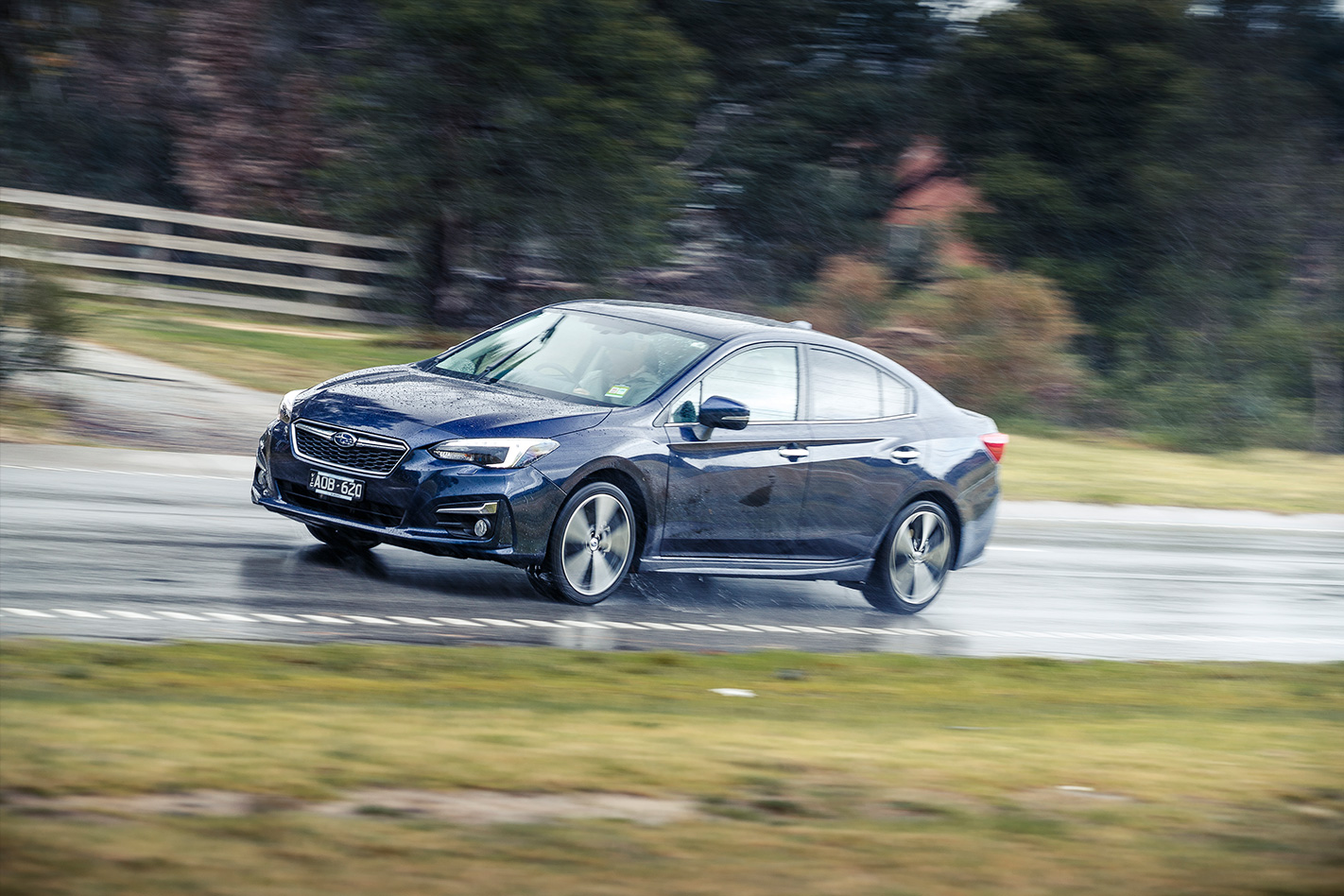
From a spectator’s point of view, the wide, swept area of the windscreen wipers provided a panoramic view of proceedings, the heated front seats cut through the icy single-digit chill brought on by excursions to the sidelines (although on its higher setting, the seats do tend to get uncomfortably hot making the low setting the preferred option), the horn sounded a cheery ‘beep-beep’ each time a goal was scored, and the sure-footed all-wheel-drive traction allowed the Impreza to park on waterlogged, grassy patches where front-drive SUVs, wearing those borrowed off-road looks but carrying none of the ability, feared to go.
But it wouldn’t be soccer without twice-weekly soccer practice. This was a trip I always looked forward to, the Impreza feeling its way through the darkness along the twisty back roads that I used as an alternative to the freeway.
The LED headlights easily picked out the road ahead, even bending themselves around the tighter corners.

It was a near-perfect season, apart from my daughter’s team failing to make the grand final play-off.
That, and the need to reach down to your feet to release the bootlid each time another load of wet gear arrived.
Improved match fitness
Subaru has made a few running changes to the Impreza 2.0i-S line-up since our blue one joined the long-termer garage. The first is the addition of reverse automatic braking, which can step in and tap the brakes to stop you reversing out into oncoming traffic.
And the Eyesight system that performed so well the other month now includes a lane-keep assist system upgrade.
But these richer features come at a cost; the list price for our test car has sneaked up to $29,240, a $250 rise.

Part Six: Glancing low blow sidelines Bazza’s Impreza
I hurt myself today / To see if I still feel / I focus on the pain / The only thing that’s real…
So sang Johnny Cash in ‘Hurt’, one of the most powerful, emotive ballads of our time. And believe me, I’ve been feeling hurt, though whether my temporary loss of my Subaru Impreza long-termer is akin to Cash’s pain and depression as he knocks on death’s door is debatable.
It started with just another drive into Wheels central in the heart of suburban Oakleigh.
My commute kicks off with a freeway run where I can set the active cruise control and relax behind the wheel, the traffic ahead defining the pace.
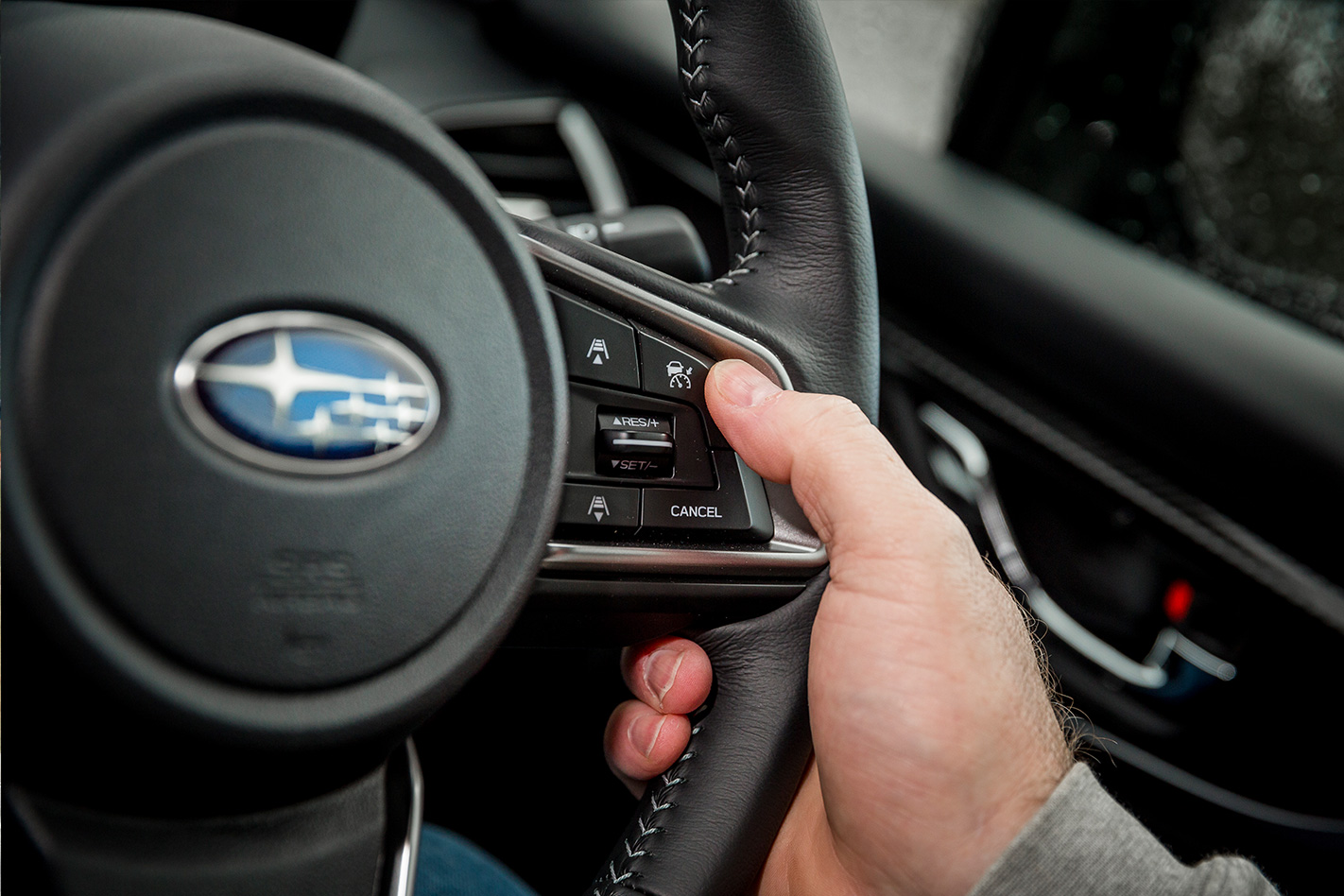
This day was different, though. We were in that moment between darkness and light, when the sun just broaches the horizon and starts to wash over the landscape. The skies were heavy with cloud. Traffic was light, so the active cruise control was set to its lowest distance threshold, with maybe three car lengths separating me from the SUV in front.
In the blink of an eye, I saw the SUV wobble slightly, and then a flash of brake lights as it bucked up slightly on its left-hand side.
I noticed it had run over an L-shaped length of square metal tubing – an offcast, I assume, from one of the many tradies who take to the road at this time of day.
But the bit of metal was now pivoting on one arm, standing almost upright. Time seemed to slow as I reacted, braking and moving to the right to avoid it.
Too late.
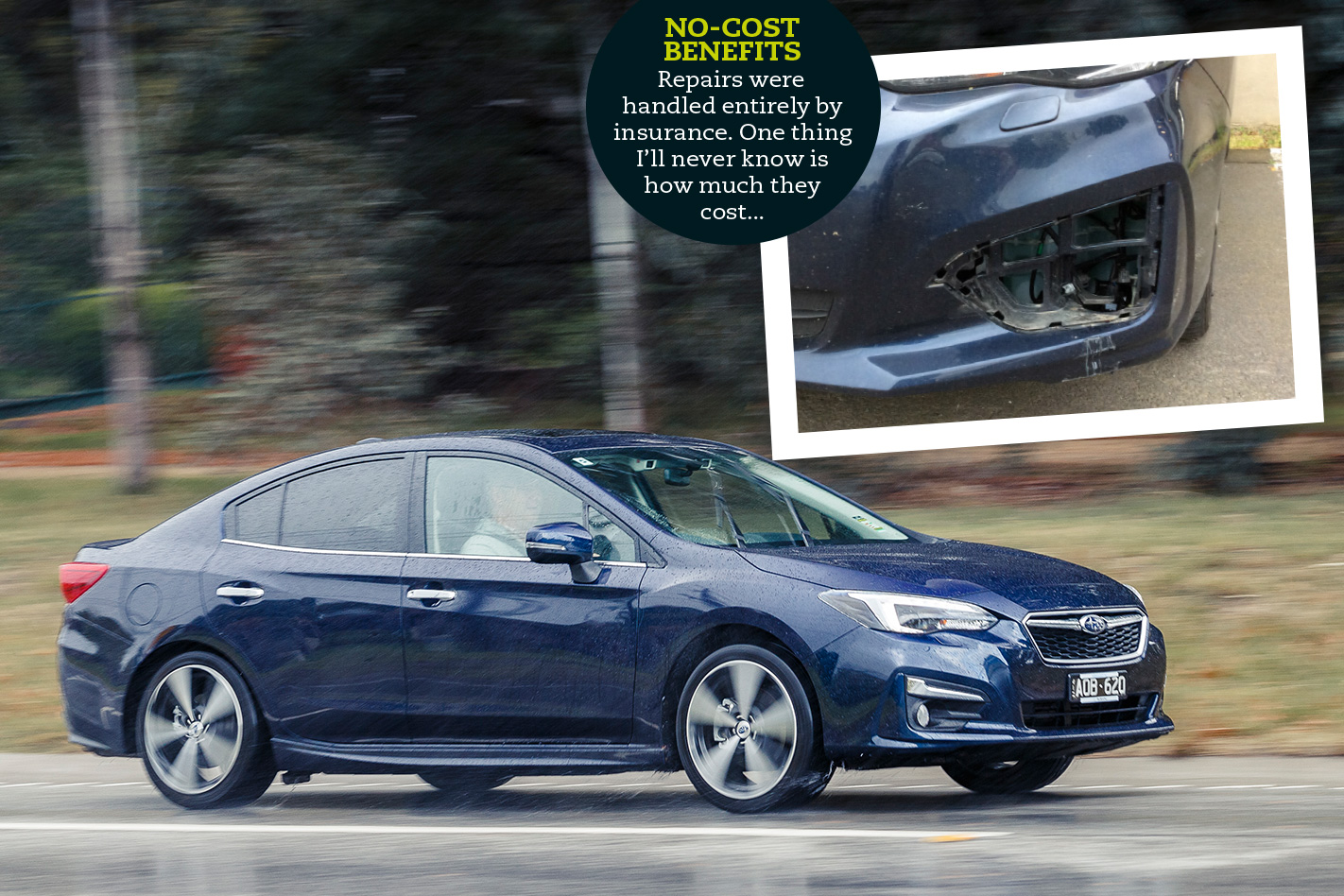
The tubing hadn’t quite fallen back to the ground. I hit it, a loud “bang” resonating through the Subaru’s cabin as its left front tyre makes contact.
The car in front had already pulled over to assess any damage, but it was about a kay further down before my chance to stop for a look arrived.
The tubing had clipped the bottom of the splitter in front of the left tyre, punching a perfect impression of its profile into the plastic. The force of the impact – roughly 80km/h – appeared to have earthquaked through the left side of the bumper bar, popping out the black foglight surround.
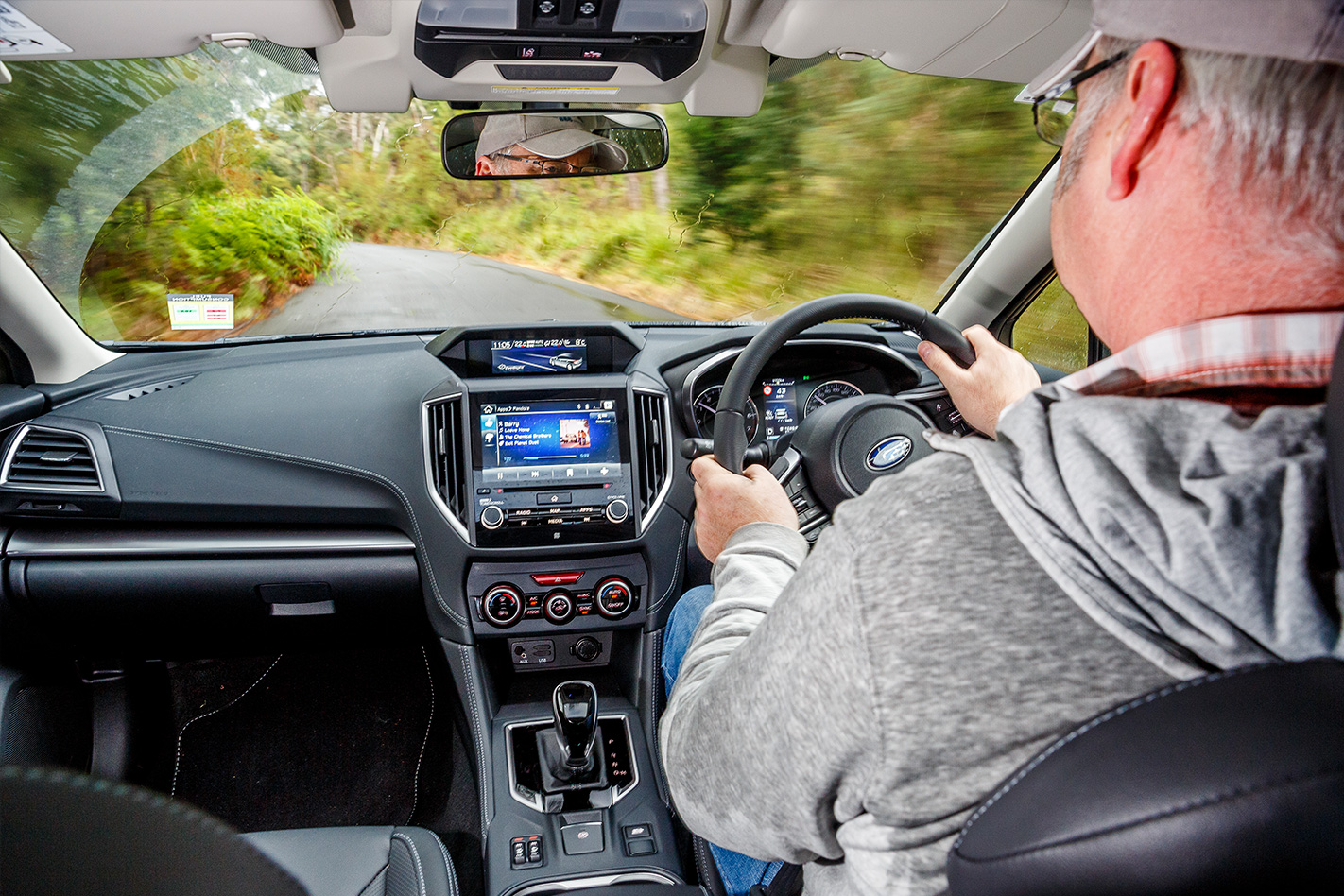
Repairs took almost a month. As I write this, the just-returned Impreza sits in the staff car park, looking just as good as the day it was delivered. We are reunited.
But I’m still hurting.
Some mongrel has nicked the iPhone charging cord I’d left in it.
Part Seven: Booted Impreza gets filled to the gills
HAVE you noticed how cars become etched in certain stages of our lives?
I grew up in the back of a Holden FC Station Sedan (and still have the scar on my pinkie where I cut myself on a door), courted in a VC Valiant, drove my first child home in the back of a Mercedes-Benz 250SE, and took my young family on memorable trips to the centre of Australia in a Land Rover Discovery.
We hit another of those significant benchmarks the other month, and this one will forever be connected with our Subaru Impreza.
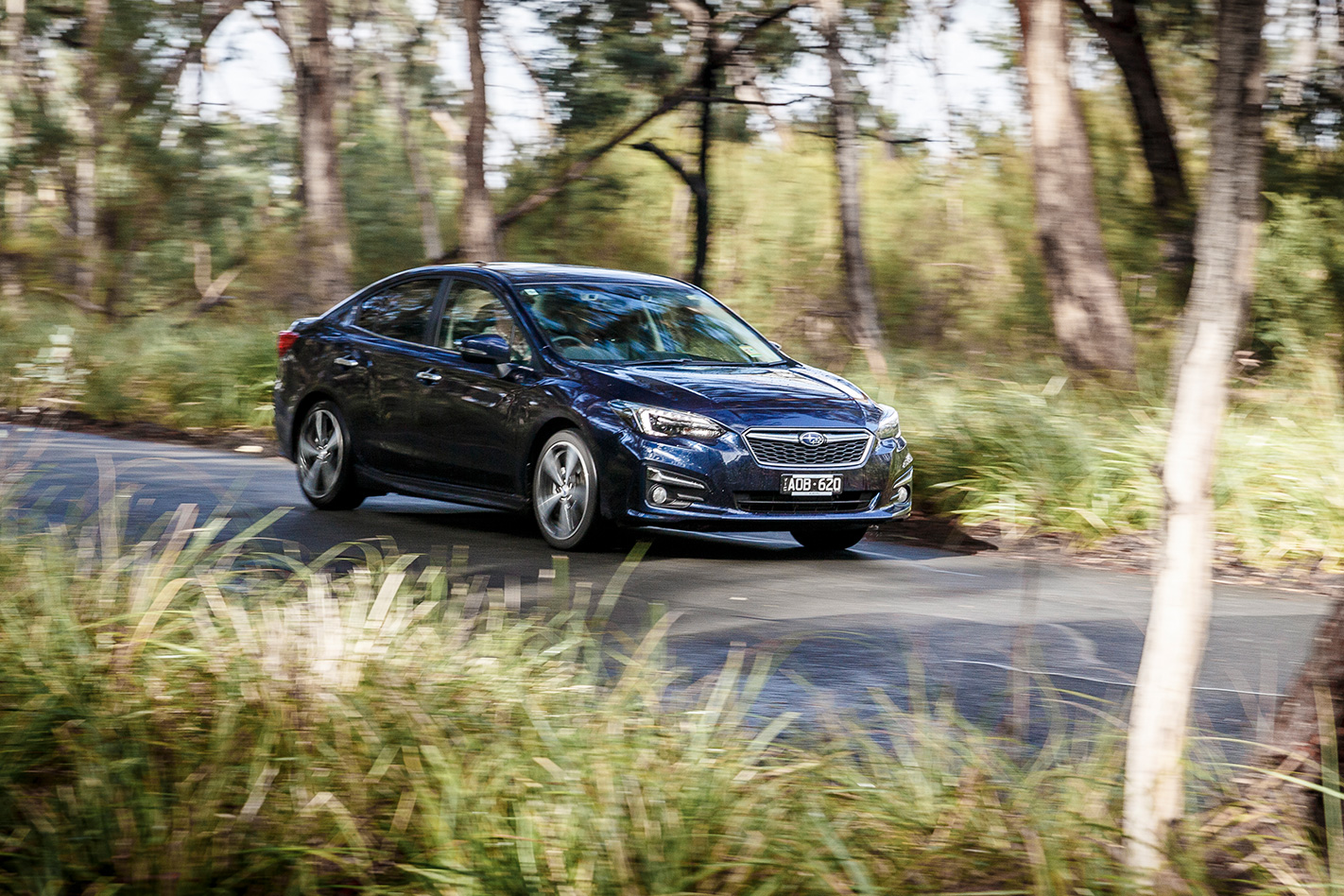
My daughters have just started their Victorian Certificate of Education, two crowded years of stress, worry and achievement that will lay down the foundations for what they will do for the rest of their lives.
But before they had even cracked a textbook, both were accepted for summer school in the heart of Melbourne; two weeks living on campus right in the centre of the city, more than 100km away.
The Subaru Impreza was tasked with the job of delivering them to their residential quarters. Straight away the Impreza had to swallow suitcases straining with the 30-odd kilograms of essentials that teenage girls apparently need to survive a whole fortnight away from home. We’d never had the Impreza this full before; the equivalent of four adults and what felt like the equivalent of a pallet load of cement bags in the rear.
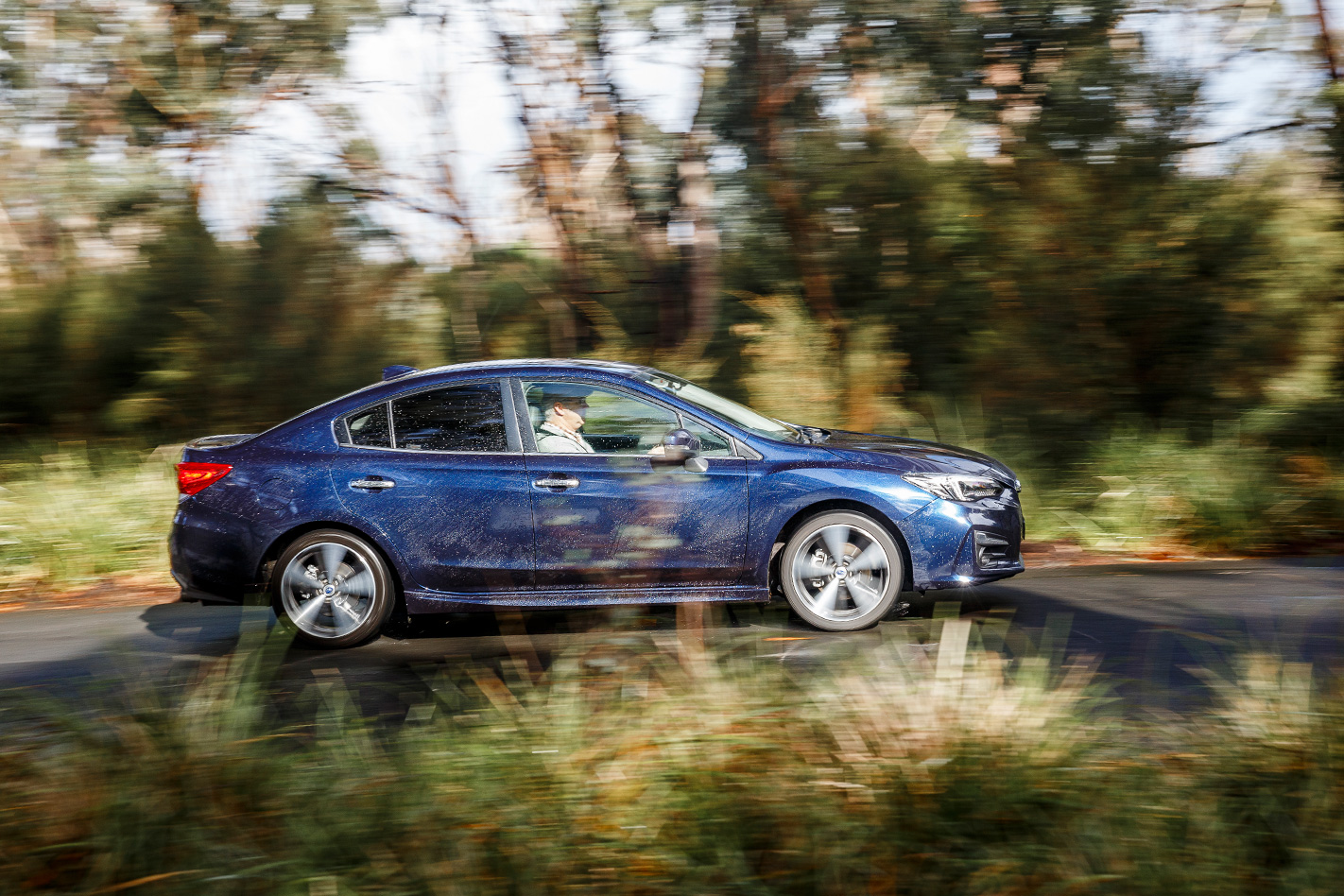
The effect all this baggage had on the Impreza was quite dramatic. I’ve loved the silky ride of the Subaru’s suspension, which one-up has glided over the road’s imperfections and undulations with barely a hint of them transferring into the cabin. Even with those sticky, low-profile 18-inch Yokohamas fitted, the ride has remained almost luxurious. But fully loaded, the Impreza struggled to make a good impression.
The ride became choppy as the weighed-down suspension – struts up front, and double-wishbone IRS at the rear – dealt with less travel. Sharper bumps suddenly became noticeable, with the rear end rebounding lazily before quickly settling.
The girls arrived safely in their dorms, and the unloaded Impreza stretching its legs for the less taxing lope home, all returned to normal. Except for our house. That’s a place where noise and movement are welcomed.
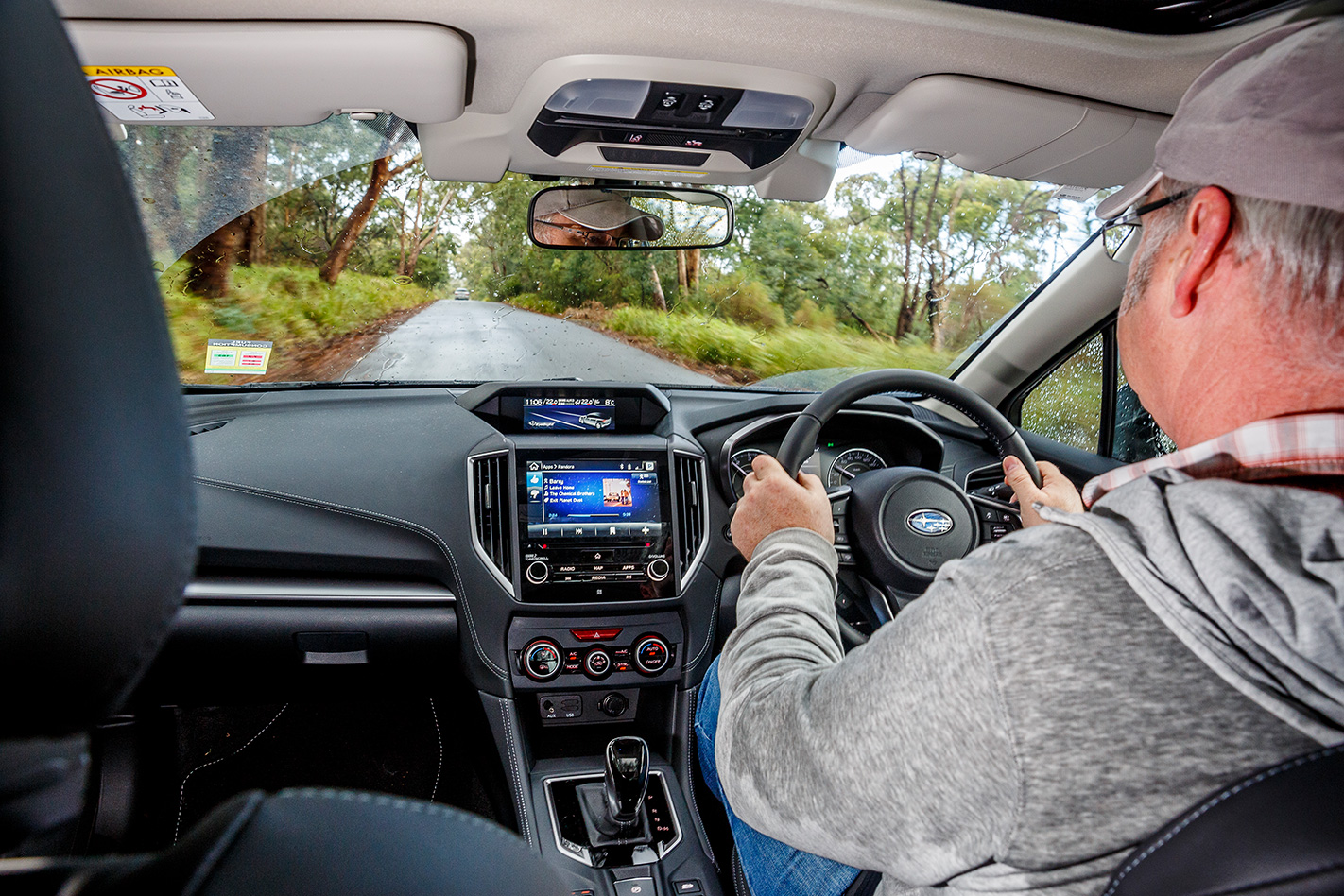
It’ll be a long fortnight.
Power to the people
I’ve found myself dwelling on the uniqueness of the Impreza’s 2.0-litre powerplant. On paper the FB20 has a peaky 115kW power delivery and a chevron-shaped 196Nm torque curve, but it’s a pretty competitive package in its class. Question is, how long can Subaru hold out its indifference to the in-line four used by all rivals?
Masahiko Inoue, Subaru’s project general manager for both the Impreza and XV, told me last year that he believes the engine’s unique layout will easily adapt to hybridisation – a key to ensuring its longevity.
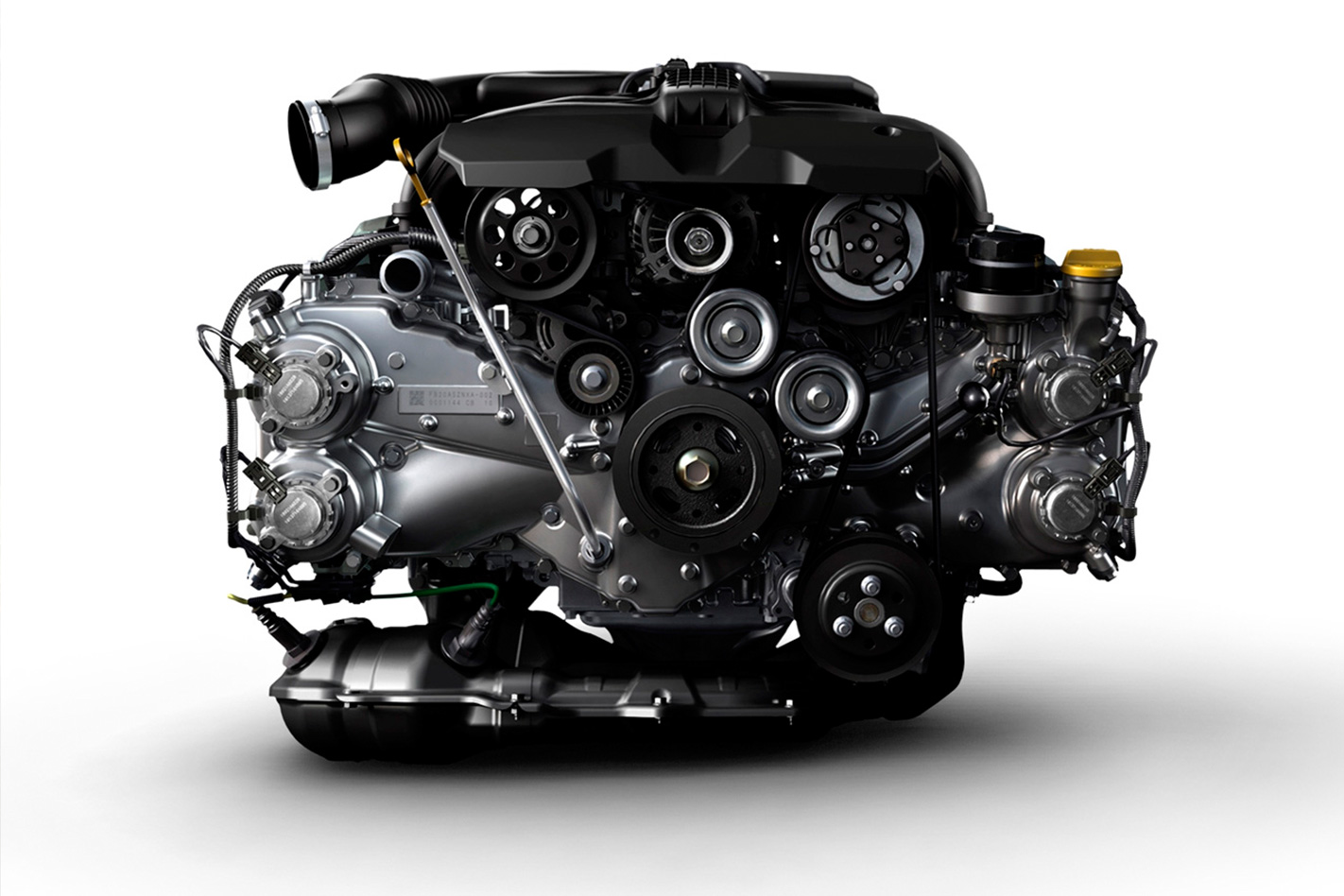
Part Eight: Subaru calls time on Barry’s extended Impreza tenure
STOCKHOLM syndrome is a real thing.
I know this, because I seem to have fallen in love with my captor, the Subaru Impreza.
We’ve spent more than six months together, with at least two hours a day on every workday – maybe more considering the crushing weight of roadworks reducing Melbourne’s traffic to a crawl – spent staring at the rear end of the car in front. And I’ve enjoyed it.
It has given the impression of saving my arse on numerous occasions; the autonomous emergency braking via its stereo-camera Eyesight system stepping in to avoid real – and sometimes imagined – danger in front.
It has more than adequately warmed my buttocks in the depths of winter – the heated seats so effective I could only ever tolerate its lowest setting – cut wide tracts of light through the dark shadows of night as the clever active beams peered around corners, and when asked, acted like a properly engaging, chuckable sports sedan.
But not every relationship is perfect, and so it is with the Impreza.
The active cruise control’s constant beeping in heavy traffic was painful to the point of some rather negative vocal feedback.
Hard, dark plastics dominate the cabin, making it feel a bit dated in the face of some surprising advances made by key competitors. The leather seats, too, were firm to the point of inducing a bit of backache on longer trips – the more comfy cloth seats on lesser Impreza variants started to look appealing for all the wrong reasons.
What struck me, though, was the ease with which the Impreza adapted to family life.
Forcing three children to fill the back row would induce typical grumbles, but once settled in to the space afforded by the 2670mm wheelbase, the complaints quickly stopped (although some grumbles about the intrusive transmission tunnel prevailed). That agreeable rear seat accommodation is also thanks to the generous glasshouse compared with some design-heavy rivals that reduce rear-seat visibility to pillbox proportions.
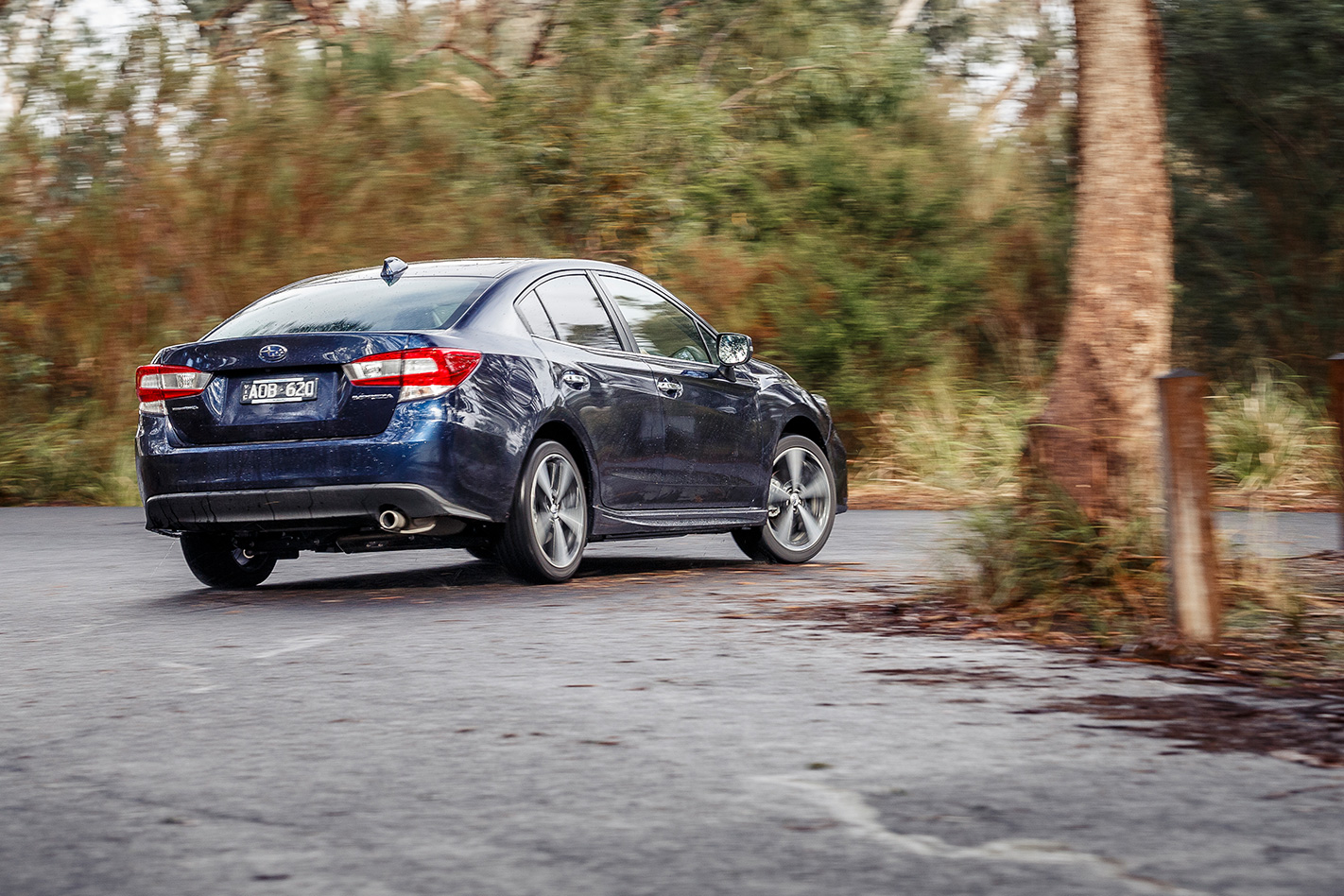
Despite all that glass, cabin climate comfort received a big tick, via an air-conditioning system that could turn over a huge volume of air on even the warmest or coldest of days, compensating somewhat for the lack of rear-seat air vents.
I never quite warmed to the boot, though. The Impreza sedan is sweetly proportioned, but a constant niggle in my brain said I would have preferred the hatchback that, to my eye at least, has a more balanced appearance. Further, trying to find the driver’s footwell-mounted boot release lever in the dark (it’s right beside the fuel-cap release) was never fun.
What shines, though, was how engaging the Impreza was from behind the wheel. Yes, it has a CVT that helps drive down the fuel figure, but tolerate the Impreza’s dim-witted steering wheel-mounted paddle shifters and tap the sweet, sweet chassis that sits underneath it, and the flaws are eventually forgotten.
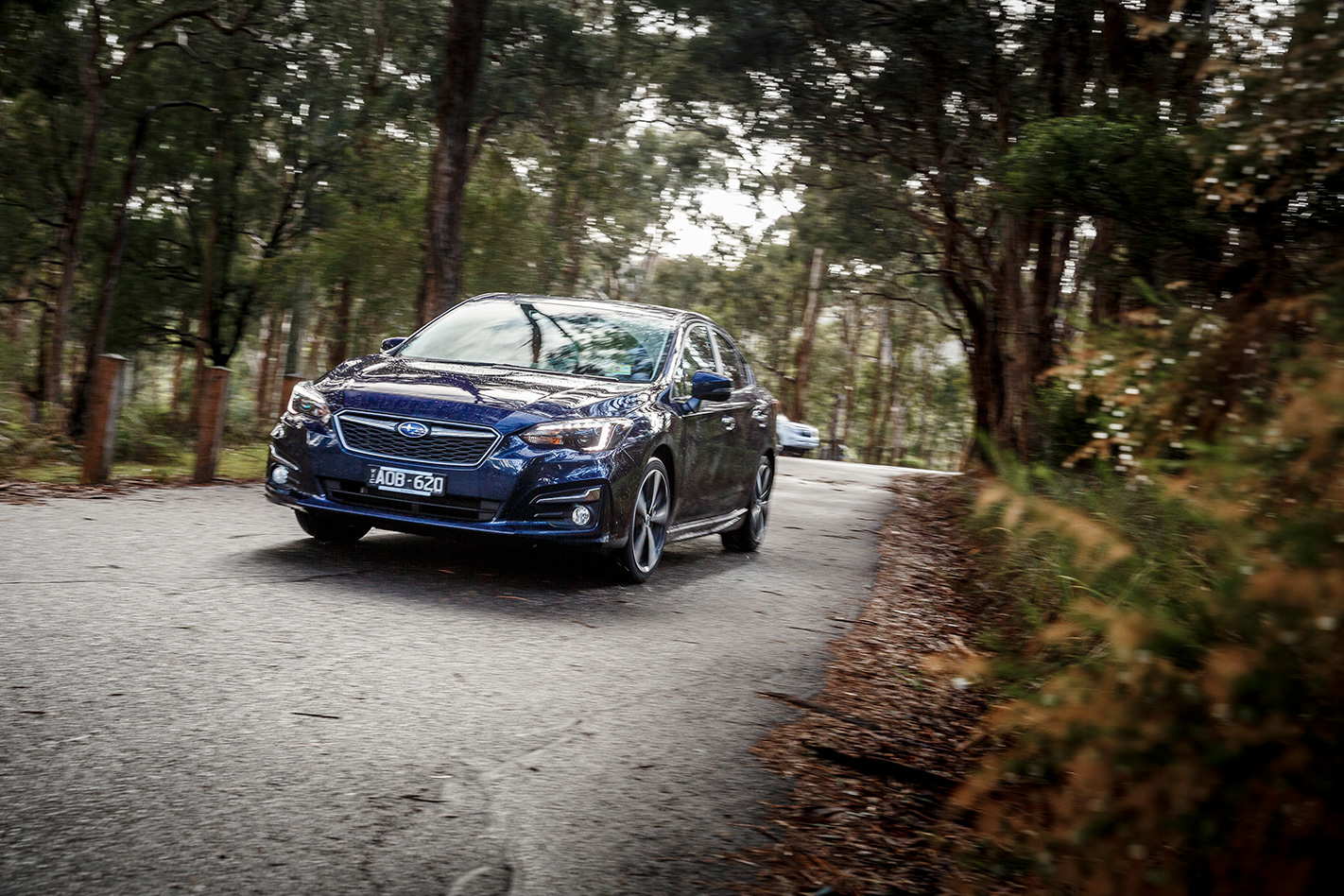
In that moment, I’ve become the romantic hostage again.
Diplomatic service
We logged an unusually high number of kilometres behind the wheel of our long-term Impreza, well beyond Subaru’s 12,500km recommended service interval.
Normally I service a vehicle by the book, but Subaru was happy to keep the sedan on the road, instead going by the recommended date for the next service. That first service would have cost me $348.30 according to Subaru’s capped-price servicing program that covers the first three rounds of scheduled maintenance.
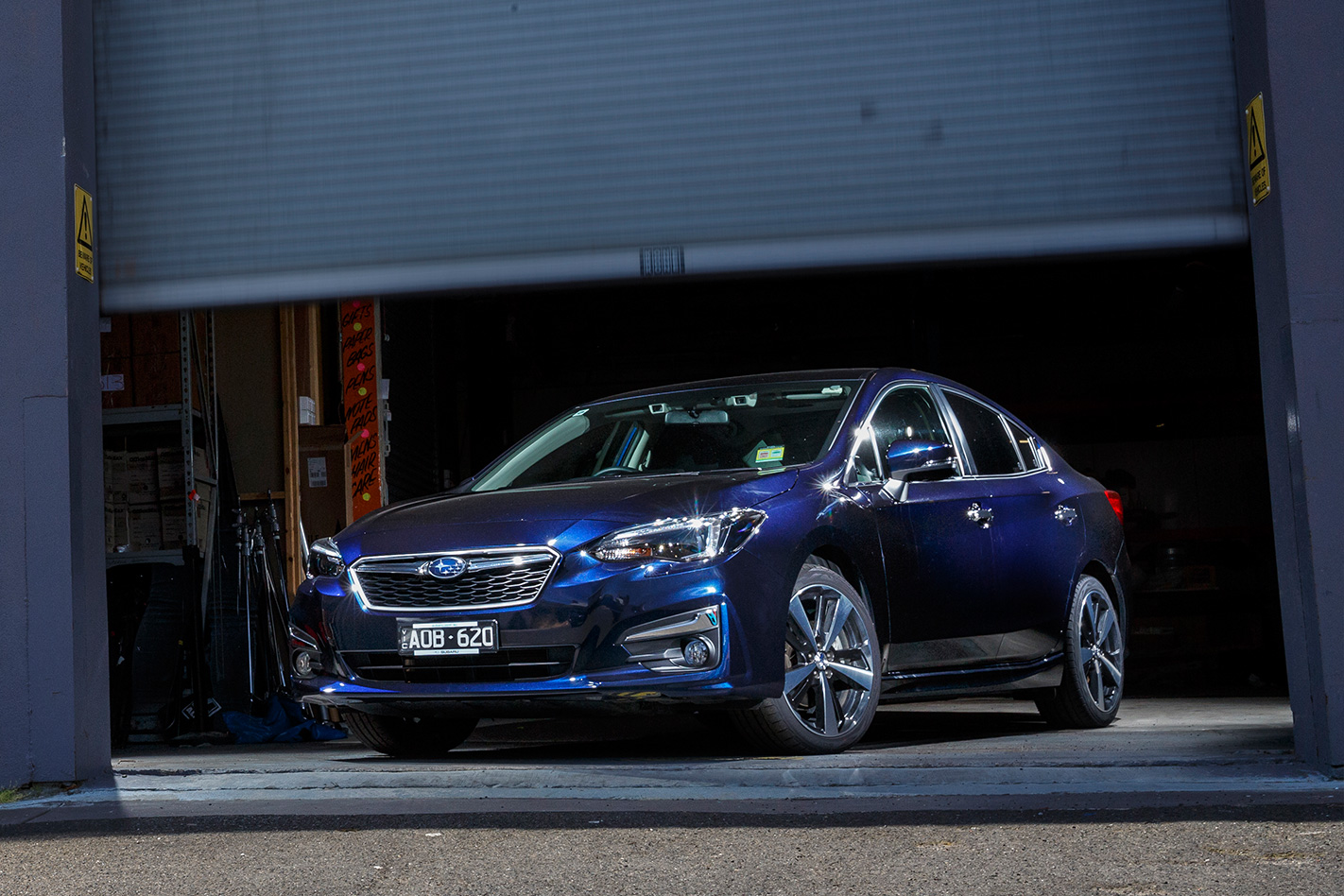
Surplus to requirements
When I mentally added up all the bits of equipment I didn’t use, there were a surprising number of them. One of the first things I switched off was the lane-assist system, when it quickly became just another annoying beep.
The CD player never turned a disc in anger, the CVT made the automatic hill holder function redundant, and the voice recognition, well, for the brief period I used it, it thought I was speaking another language. I did miss the clarity of digital radio; the Subie’s crisp audio was made for it.
MORE: Subaru Impreza Range Review MORE: Subaru Impreza Specs, Range & Price

